
Blog 46 by Mick: Taking the High Way, As Opposed To The Highway

OMG!!!! A MAP!!! yep, we are getting better at this blog thing. Here is our route through Ethiopia. Brown is gravel/offroad, green is tar and pink is a car. this post goes from Yabello down the south to Harar in the east, a bit over 1500kms
Our cheap little room afforded us a pretty uncomfortable nights sleep; the room was little bigger than the bed itself and the bed was pretty small to start with. And ventilation wasn’t high on the architect’s priorities when the hotel was designed either. We went out to try and get some food and failed, although we did get some Ethiopian coffee and sweet tea for 2 birr, about 10USc, per cup. Leftovers from last night’s dinner of crackers would have to do for breakfast…

Outside the tyre repair joint in Jabello sometimes also spelled Javello. Check the kid on the left. Hooters shirts are surprisingly common in Africa, probably donated by all the angry wife’s after their husband’s drunken night out on the town. I highly doubt this kid knew what he was wearing but hilariously he has got the posture right – hand down pants.

Tyreguy cleaned up all the surfaces, patch and tube alike, with a little grinding stone on a small pneumatic dremel type thing, it worked really well. Once cleaned he was careful not to touch the surfaces and used proper vulcanising glue on both patch and tube. Waited until tacky (about five minutes), then applied patch and bashed enthusiastically with a rubber mallet.
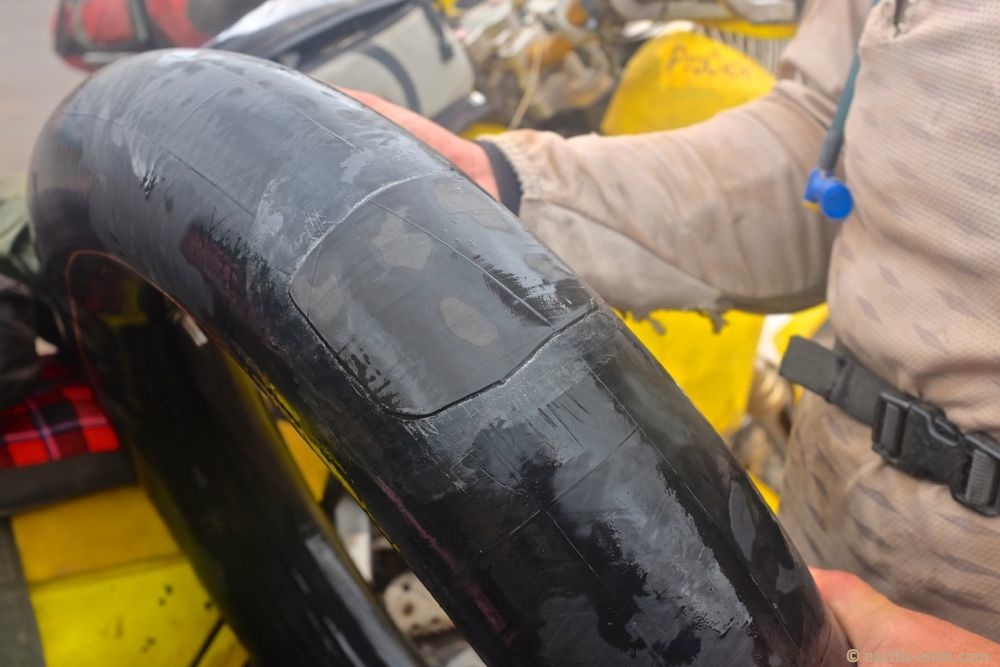
One of the patches after testing. He did a good job, and these patches have been used since and held no problem. Much better than the crap I had bought in Botswana to replace what I brought from Australia.
With yesterday’s flat tyre, we needed to sort either a new tube or at least some new patches, preferably both. We were directed out to the highway where we grabbed some fuel after lining up for about 20 minutes. Petrol shortages in Ethiopia are widespread, meaning that when a fuel station gets a petrol delivery, every petrol vehicle within range lines up and fills every vessel they have. We waited behind probably 8 tuk-tuks who filled their tanks and then two to three 20 litre jerry cans each. Patience was required, especially when they pushed in line and then wouldn’t look you in the eye when you knocked on their window…
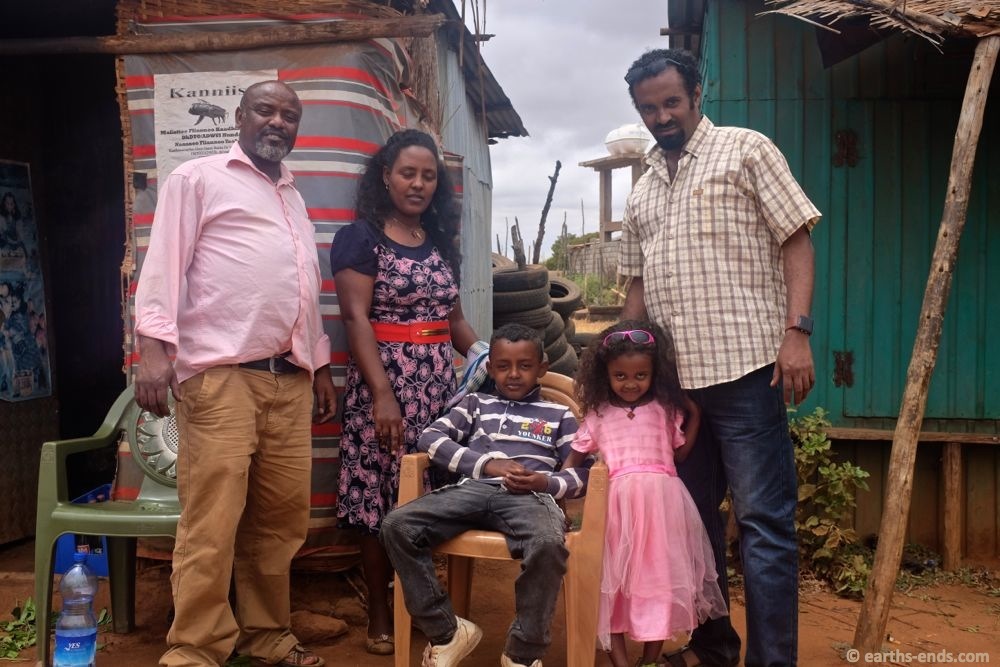
We ran into the Ethiopian family we met twice the day before again. They needed a patch put on a flat for their old 60 series Landcruiser. Import duties are so high (130% on top of purchase price) that old cars are looked after and are highly valuable.

Their little girl.
We quickly found a tyre repair guy on the edge of town. He was busy with plenty of jobs, generally a good sign, and he was pleasingly fastidious when he got to repairing our tube. While he didn’t have proper patches, using pieces of old tube instead, his preparation was methodical. He charged us the same as everyone else, a very reasonable 30birr (~1.50USD) per patch, and did such a good job I had him remove a crappy Chinese patch from another tube and got it repatched as well.
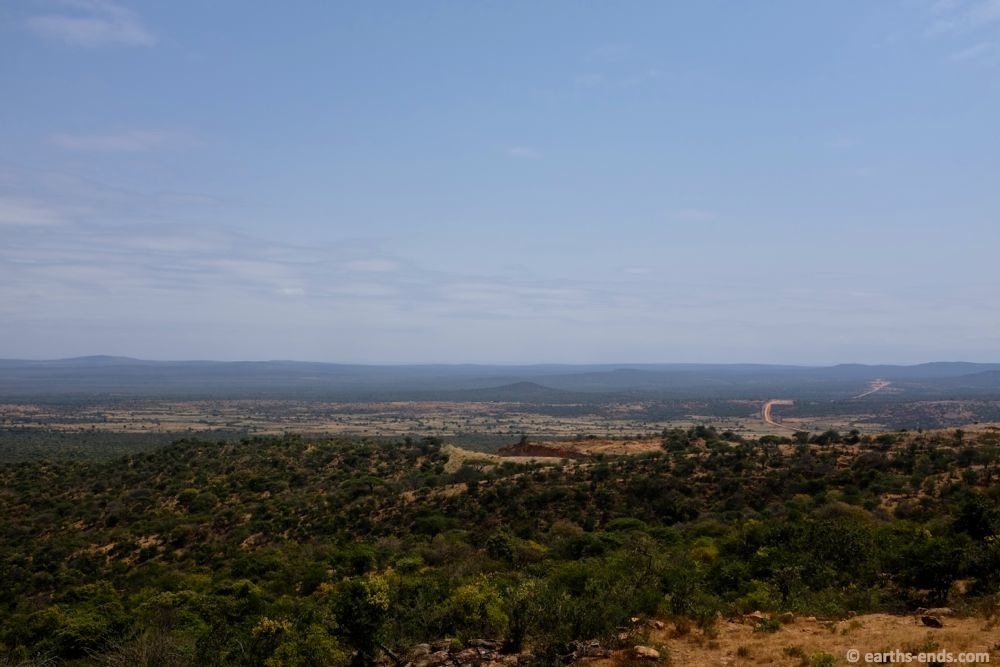
Views of the riding for the day east of Javello.
Not far from the edge of town we were on good gravel heading east. We had no gps maps or tracks for where we were going and were following a list of town names for a route that came highly recommended by our biker mate Caleb. First town of Herero was about 85km away where we stopped for lunch. We had no idea what anything was called so just used the internationally recognised sign language for food and waited to see what we got. We were swamped by locals staring at us until the restaurant owner grew frustrated and chased them away with a shepherding stick, but they settled and reformed about 10m away, safely out of stick swinging range, and stared at us from there instead.

The riding near Herero. After a late start waiting for fuel and sorting tubes, we did get very far until stopping for lunch.
We got some bung directions as we finished lunch and 25km later we ended up in a dead end village, literally and I’d guess probably figuratively too. On our return to Herero, we were directed onto another road heading south-east when the town we were aiming for, Negele Boreno, was northeast. Confusion abounded… we persisted nevertheless. We descended a mountain pass (about 500m according to the gps) and it was obvious we had changed region. Sandy plains replaced fertile mountains, brown replaced green, and population density dropped noticeably.
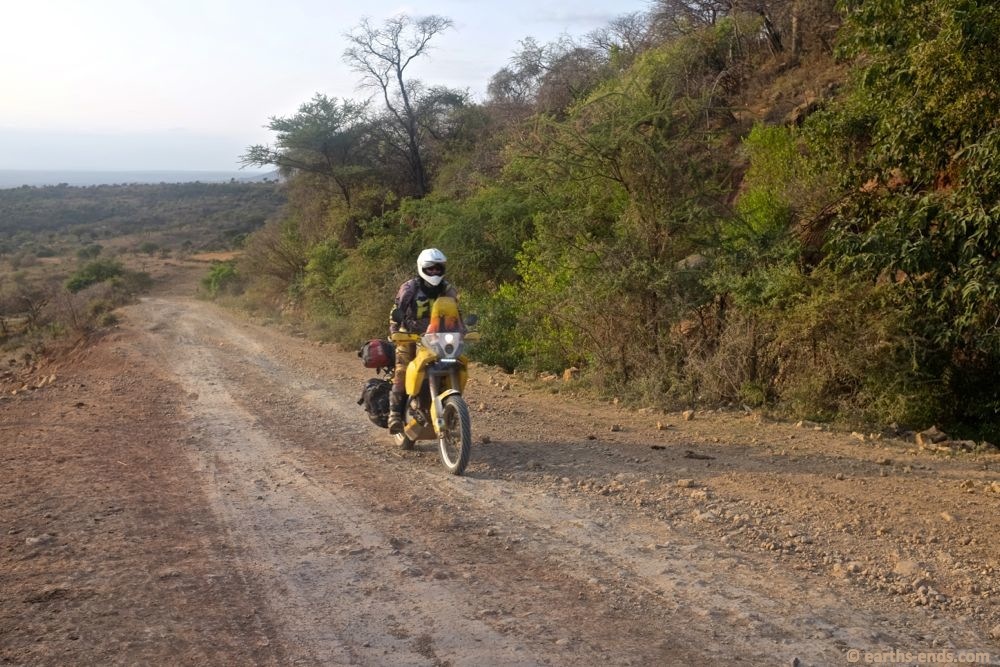
Pushing on towards Negele Boreno
As we entered the next major town, we came to a police checkpoint. The policemen waved at us to ‘wait there’ while he ran inside a neighbouring building, a big officious looking thing surrounded by many pristine Toyota Landcruisers. 5 minutes later a well dressed and well spoken guy came out and asked where we were going.
“Negele Boreno tonight, then over Bale Mountain tomorrow”
“Do you have a permit?”
“ahhh no…. do we need a permit?”
“Why of course, this is Somali Province. Because of Al Shabaab you need a permit to travel”
“ooooh…”
Without knowing, we had entered the Somali Province of southeastern Ethiopia, a hotbed for political unrest and gateway to Al Shabaab, hence the checkpoint. Whoops… Thankfully the guy, I don’t even now if he was police or what, was reasonable, and after chatting for a while I think it was obvious to him we were silly tourists and he let us on our way without the permit, after assuring him that we were heading north and not further east towards Somalia. Heading that way was about the last bloody thing I wanted to do so I was very happy to promise him this.

Some nice views and riding north of Negele Boreno
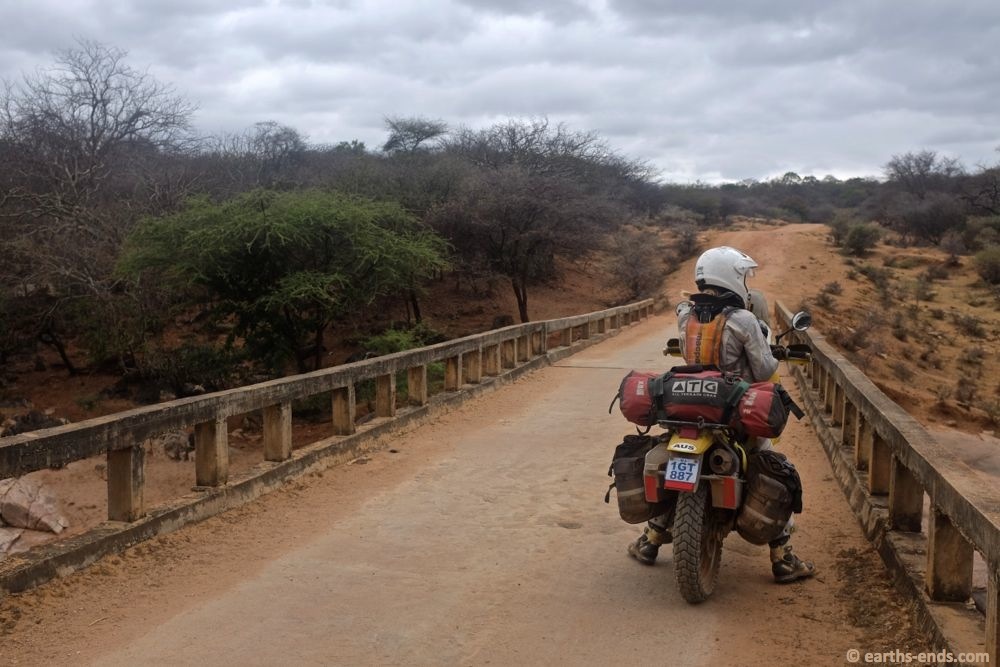
Some of the scrubby brown landscapes of the Somali Province of southeastern Ethiopia.
About 30 minutes before sundown we arrived in Negele Boreno and found a decent looking hotel for 150 birr. But after we had brought all our stuff inside and gotten changed, the price jumped to 200 birr. Cheeky buggers. We tried just giving them 150 but they were insistent so we coughed up the extra 50 birr (USD2.50), and then took our dinner business elsewhere. We were both fatigued and the idea of just chilling in the hotel restaurant with a cold drink was glorious, but after being shafted we found somewhere else. We did the same for breakfast.
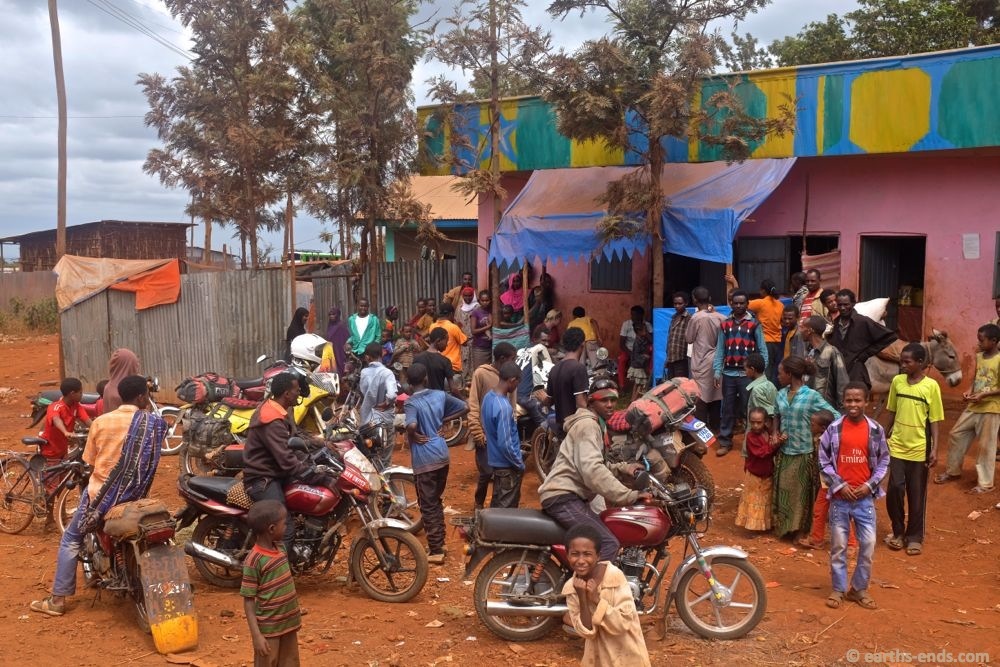
Our lunch stop before riding up Bale Mountain. Naturally, half the town came to look at us. Luckily we chose a small town so there wasn’t too many people.
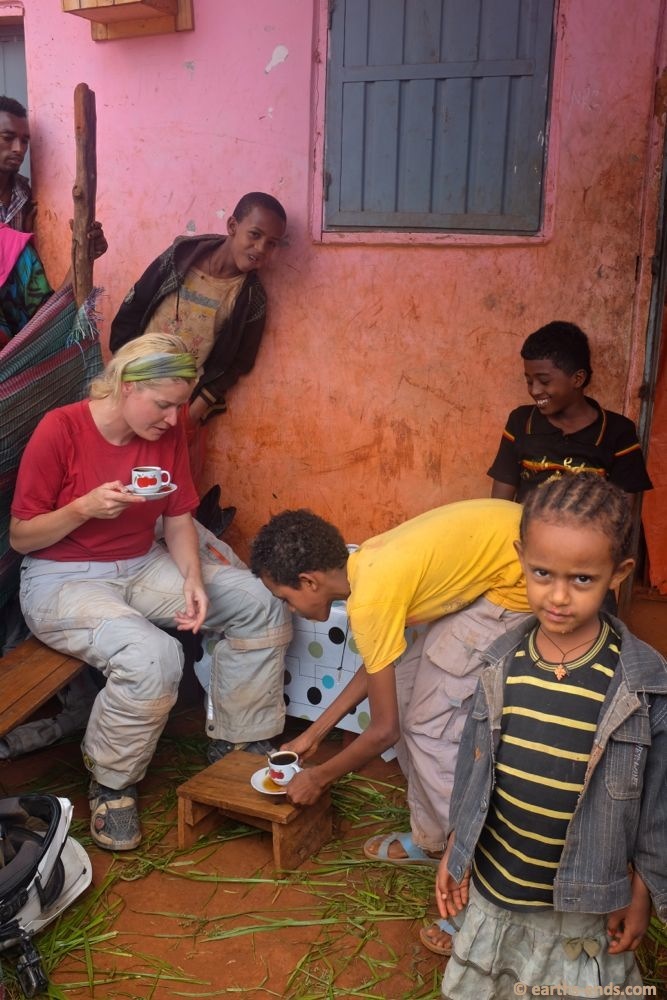
Coffee! It’s not just an institution like in the west, it is part of their history and ingrained in their culture. Coffee is native to Ethiopia, specifically the Harar region, and as be drunk for millennia.
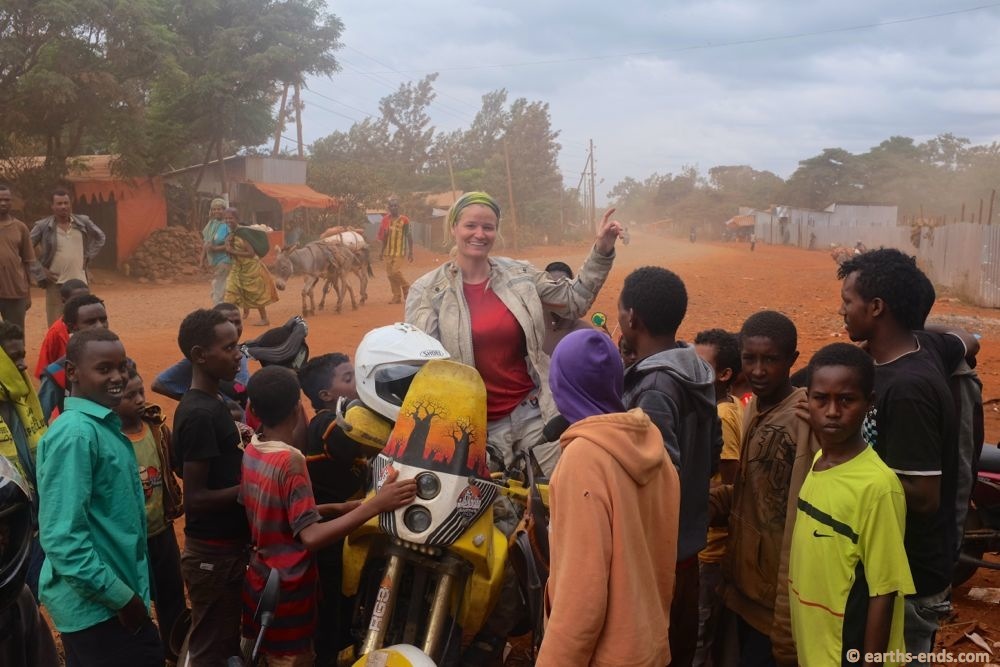
Leaving town.
Negele Boreno was a big enough town that we were able to get some cash and fuel before heading off north on some nice winding gravel roads. It was picturesque but slow riding as it almost always is in Ethiopia, we were only averaging about 45kph. Lunch was coffee and peanuts on the side of the road, and not long after we were ascending sharply into lush jungle. It was a steep ascent up Bale Mountain, and after riding in fog and mist and scenery of the Lord of the Rings variety, we pierced through the cloud into blue skies and sunshine.
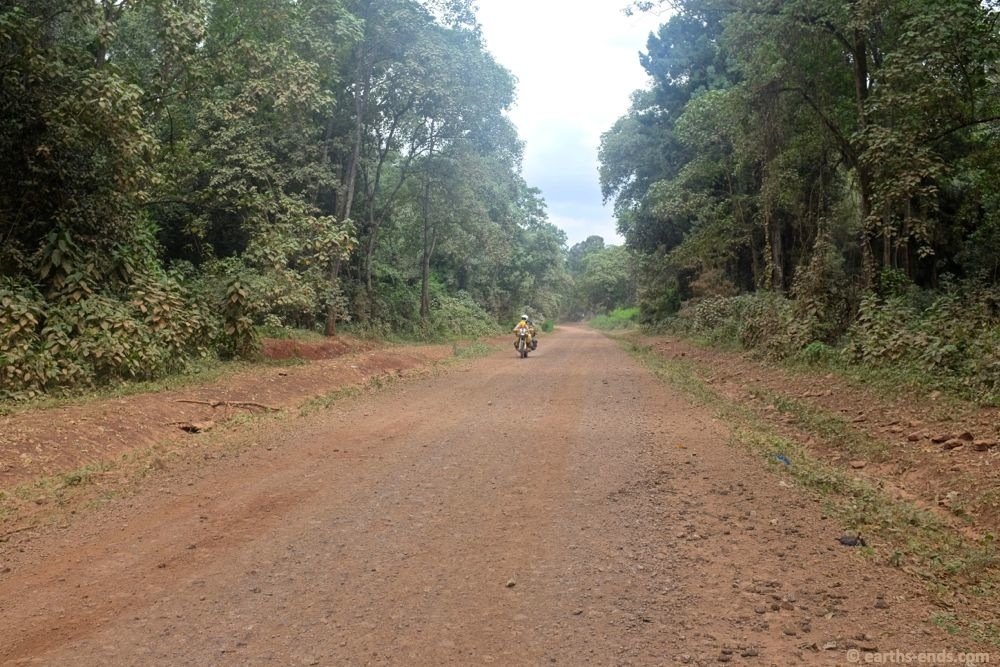
Ascending into jungle
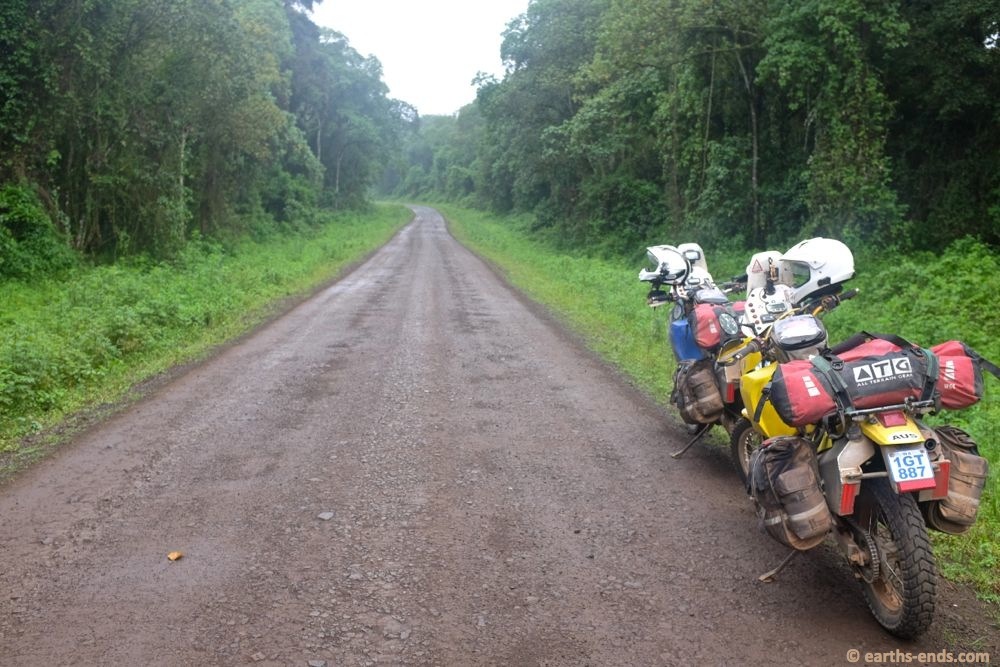
And then we stopped for wets. It was starting to rain off and on and was cold.

Some of the foggy riding on the way up.

Tan showing off her very ugly, but very effective over gloves. We had just poked our head through the fog and were greeted with this.
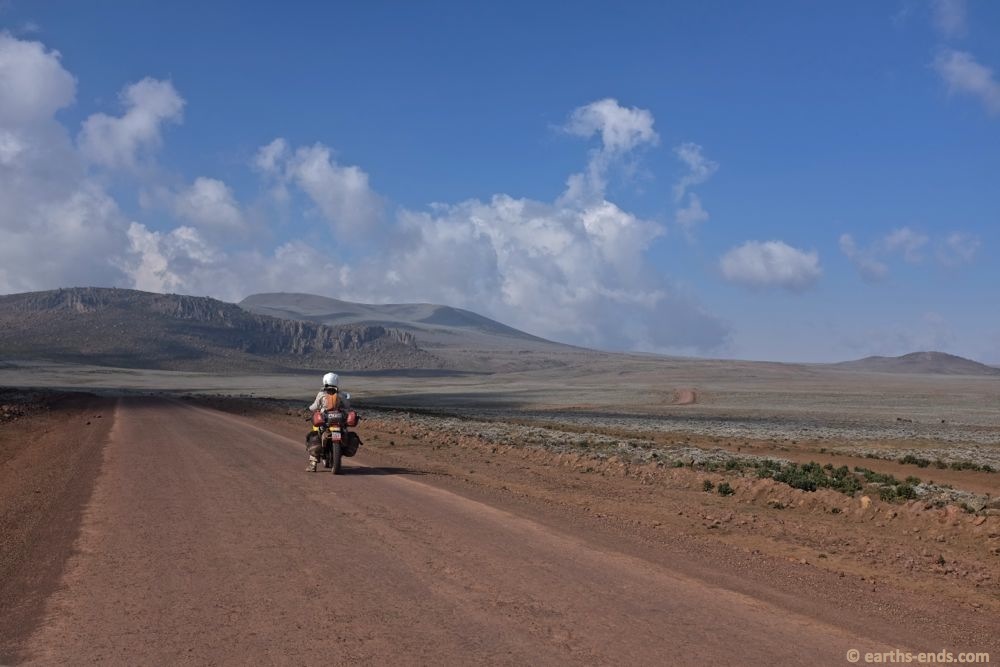
The road over Bale Mountain. Highly recommend this ride – surreal scenery.
We were above 4000m altitude on one of the highest roads in Africa, and the poor DR’s were struggling in the thin air. The mountain had a definite alpine feel about it, no trees, plenty of grass and it was quite cold even with the sunshine. We descended down the other side and found a descent hotel, complete with toilet seat (always a variable in Ethiopia) and guessed at some things on the menu for dinner.

There is a road to the summit, named Tullu Deemtu, and at 4377m it is the highest navigable road in Africa. The bikes were not happy at over 4000, they didn’t want to idle and coughed and spluttered when revved, so I wasn’t keen on the idea of riding up a few hundred metres more.

Great views. Was pretty cold though, somewhere around 8 to 10 deg C I’d guess.
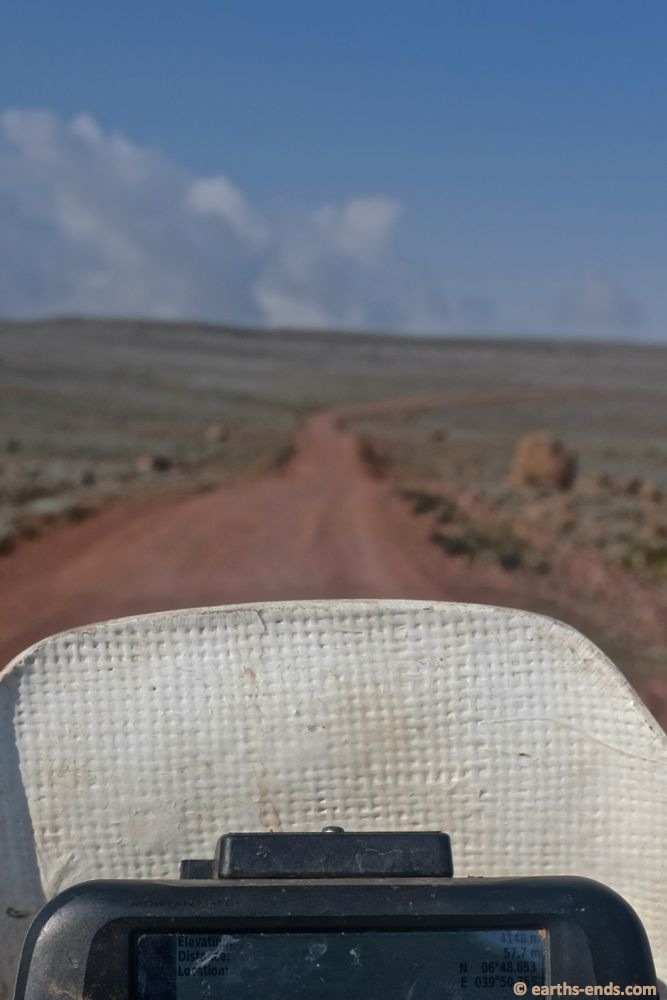
“Taking the high road”. If you look closely, the GPS is showing 4148m elevation. This was about the highest we went, maybe a few metres more but this was about the max.
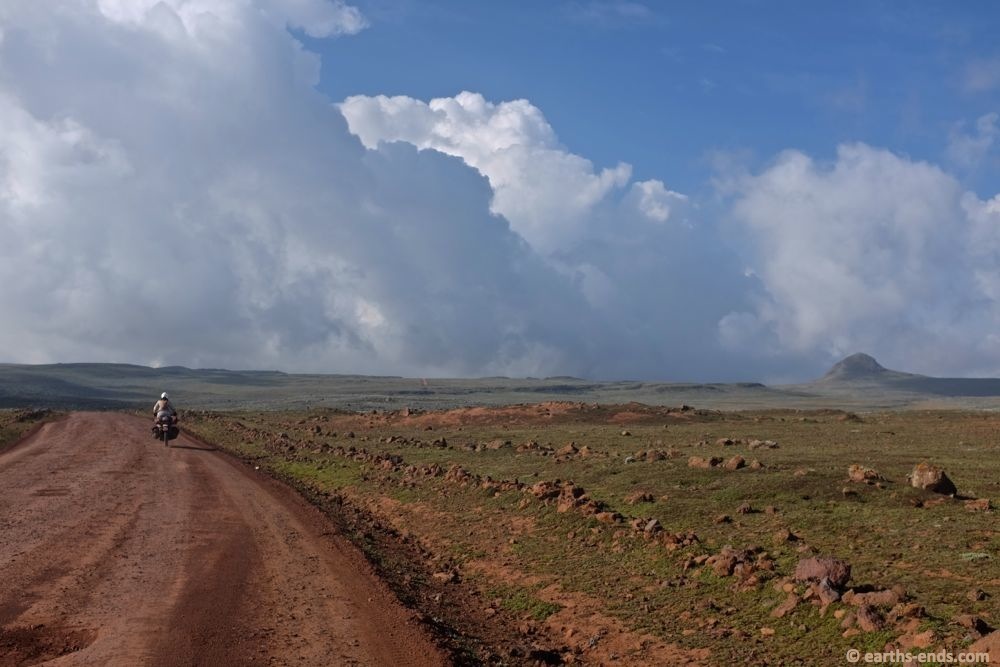
Enjoying the alpine feel.
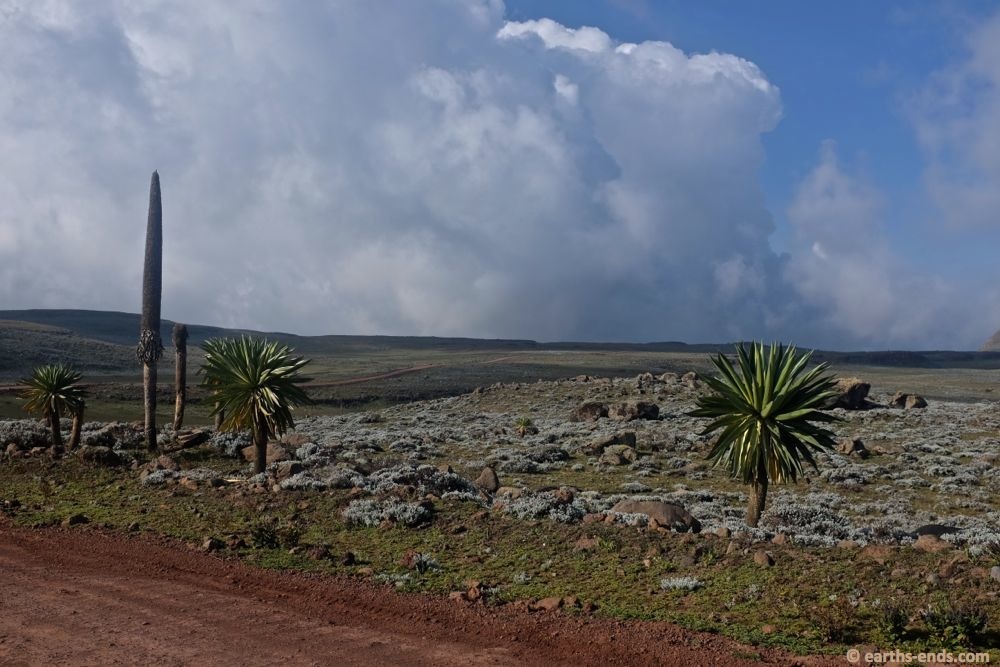
Definitely unique flora up here.
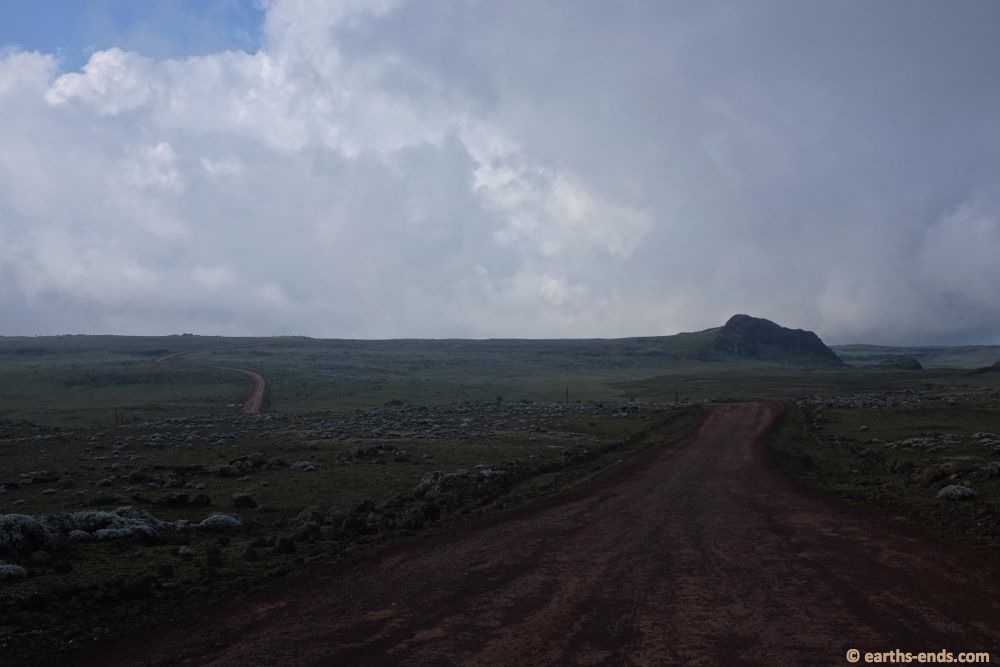
More views of the open road. We didn’t see anyone.
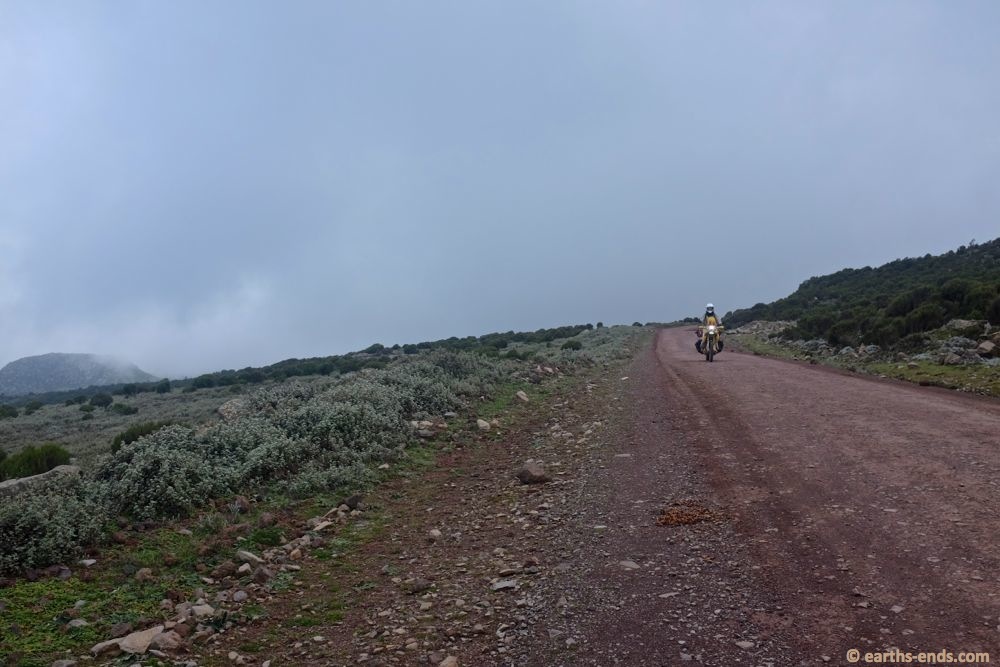
The descent down the other side.

Panorama of the northern side of Bale as we descended towards the towns of Goba and Robe.
It was a late start the next morning, after a couple days of riding we needed a chilled out breakfast with plenty of tea, which was then followed by the obligatory 30 minute wait in line at the fuel station. We were following some rough directions so made our way east to Goma and then north to the town of Ginir where we should have been able to find a road north to the Islamic holy town of Sheik Hussein. The directions were rough though, and after some real nice winding gravel where Tan hit a cow (ok it was just a calf, and a very small one at that, and it was just a very slow nudge – everyone was fine), we reached Ginir where we got turned around and sent east. We were told the turnoff we needed was 5km away, so we stopped often to confirm and it seemed we were on the right track. 35km later we found the turnoff. Directions aren’t a strong point here that’s for sure.
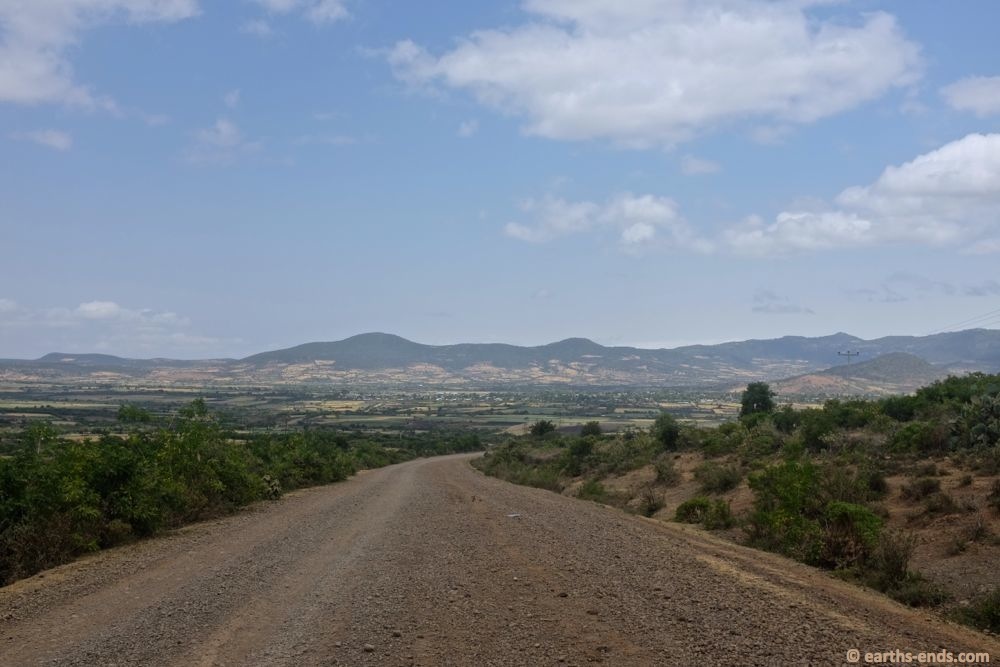
The view back down towards Goma on the road north to Ginir.
Lunch was an eye-opening affair. After finding a fruit bar with no fruit and then a kitfo restaurant (kitfo is an Ethiopian ‘specialty’, it is diced raw meat… we passed), we found a hotel where we could eat. We attracted heaps of kids who could not help themselves but grab at the bikes and our luggage and rudely beg for money (“You! You! Give me money!”), but thankfully the owner of the hotel took control of security and kept all the kids away with a few well aimed rocks and a menacing swing of a stick.

As we went north the road narrowed and narrowed to single lane. As usual, stock animals were everywhere.
That was the eye-opening bit. One thing you start to observe after a few days in Ethiopia is the common petty violence; a swing of a stick, a thrown stone, a cracked whip, a swipe around the ear or just a yelled word, it is everywhere. There is little to no respect for property or each other, so often kids would play with the dash and our luggage, or hang around a restaurant, or swing on a fence or door or do anything really, and no-one ‘asks’ them to stop. It is a stick or a rock that is used to communicate. If a person is unwanted, they are not asked to leave, they are threatened first and then chased/pushed/hit with a stone or stick or hand. We saw this on many occasions. While its only petty stuff and no one seems to get genuinely hurt or upset, the physical threat in itself is harsh and very different to the African cultures we have experienced to date.
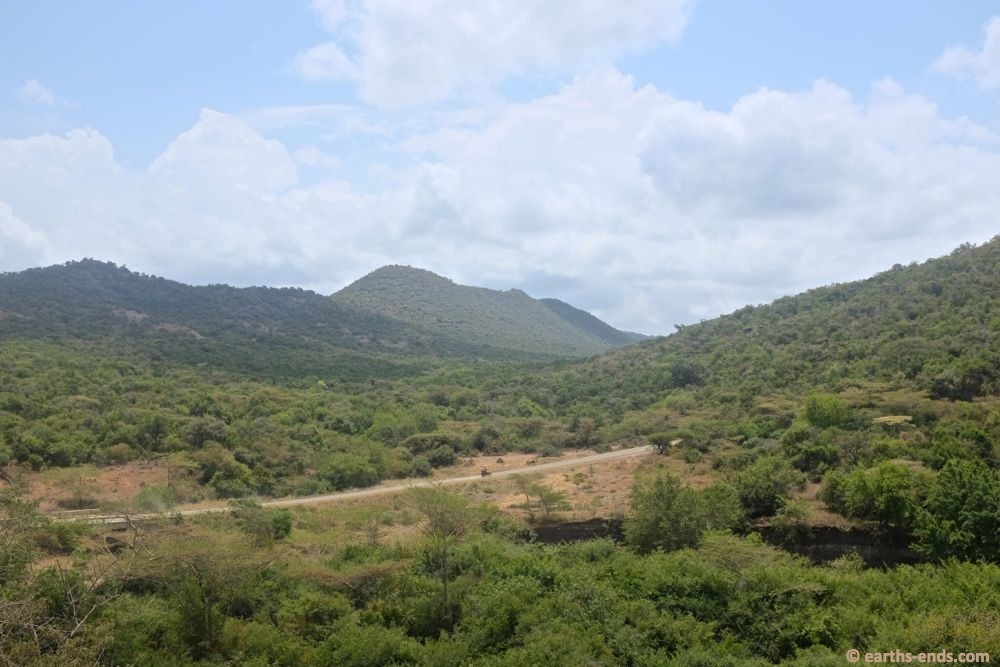
And more and more nice riding.
Lunch was tibs and injera and a few cold beers. That was a very pleasant surprise about Ethiopia, the local beer is decent and cheap. The owners of the hotel then gave us a few cups of local coffee, which had a slight salty and buttery taste, and some bbq’ed maize to snack on which was very thoughtful. And a very rare thing indeed in Ethiopia to receive anything for free. As we were leaving we were approached by a guy who welcomed us to the village in wonderful English, “please give me the opportunity to be the first to welcome you to this small rural town”.
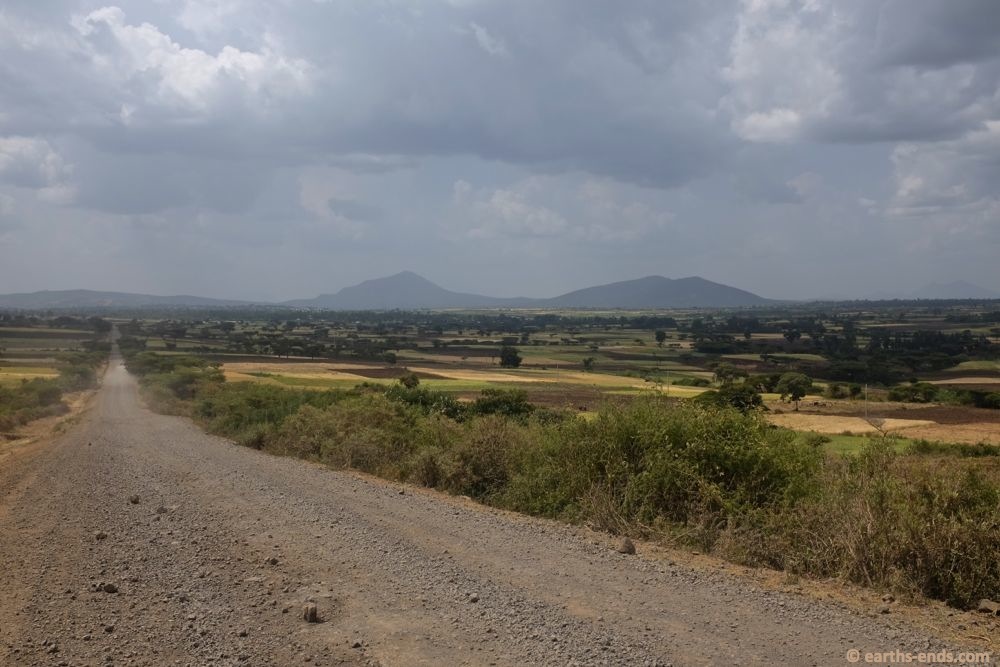
The road west of Ginir on the hunt for our turnoff north.
He told us that he was a medical doctor and also a teacher and learnt English from living with American Peace Corps in the late 1960s. He explained that everyone was very happy to see us as this place never receives foreign tourists and that we were probably the first white people the excited kids had ever seen. This was later reinforced when we pulled up just out of town so I could put on my jacket. A guy jumped straight out of the field to talk to us. He was so damn happy and spoke English quite well. He warmly welcomed us and excitedly asked a few of the usual questions (where you from? where you going? how fast does the bike go? ect). It was a nice moment.

Yet more views and gravel riding as we got closer to Sheik Hussien.
So we made only about 215km for the day and rolled into the tiny town of Sheik Hussein in the late afternoon. We were hoping for a cheap room and a cold coke but Sheik Hussein is so far off the beaten track there was nothing, literally nothing for us to buy. There was no little guesthouse. There was no coke, let alone a cold one. And certainly no beer. We couldn’t even get a tea, and little tea stalls in Ethiopia are everywhere!

Inside the abandoned tourist information complex at Sheik Hussein. As per normal, we drew a healthy crowd of onlookers.
Sadly, even this far from civilisation/this close to the arsehole of the earth (depending on your optimistic/pessimistic slant), chat had arrived. ‘Chat’ is a leafy plant that looks a bit like tea, is native to Ethiopia and an addictive narcotic when chewed. Which it is in huge proportions – chat is the largest agricultural product in Ethiopia and is exported widely (both legally and illegally). We had seen this stuff all over, and had been warned of the effect it has on people both short and long term.

The Shrine to Sheik Hussein in the morning light.
But while we had seen quite a few people chewing this stuff and staring off into space with a bemused look on their face, Sheik Hussein was our first experience with a long time hardcore abuser. Someone who has fried their brain to the point they are merely a standing, staring, dribbling and ranting shell of a person. We came to call them “chat zombies” i.e. the living dead who feast on chat, rather than the more conventional zombie diet of brains. While they appear similar, the green leafy dribble of the ‘Ethiopian Chat Zombie’ is a giveaway identifier. Personally, I tend to think the ‘Common Hollywood Brain Eating Zombie’ might be less scary.
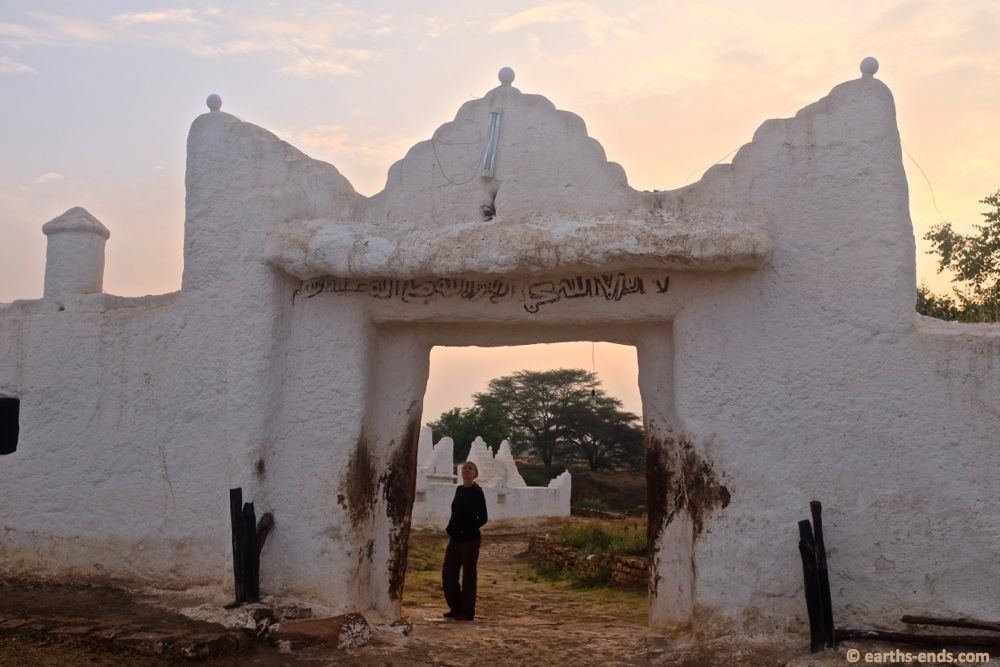
See, we do get up early in the morning. On occasion. Ok, very rare occasion.
We stopped to ask someone where we could stay and I get a tap on my arm and turn around to see this starving bony fella in nothing but some torn, stained rags which may have been shorts at some stage, with green spittle dribbling down his hairy chin from a near toothless mouth, and crazy crazy eyes. Those crazy wide non-blinking eyes that you know are open and looking but aren’t seeing anything. This guy is yanking on my shirt and jabbering away, but it wasn’t a language, just grunts and slurps through his leafy green spit, and those crazy fucking eyes. Tan turned around and yelped – this guy was a fright.
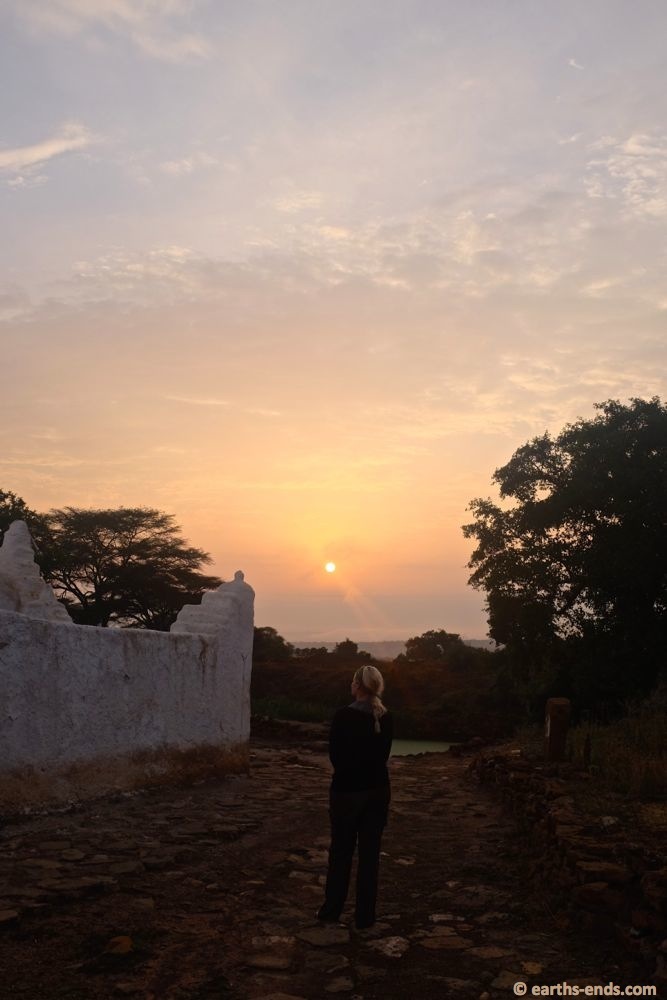
Our soft western feet suffered.
Thankfully Tanya was talking to someone far more useful than the horrid creature dribbling on my left arm, and led us down the hill with a huge throng in tow. Luckily basic motor control wasn’t one of the chat zombie’s strong points and he couldn’t keep up. We were led to a fenced compound with what looked like an abandoned building inside. Looks weren’t deceiving in this case. We found someone who spoke English and the only accommodation in town was the old and unused tourist information building in front of us.

On the inside. There were plenty of inscriptions in the mud.
The English speaker grabbed a random piece of paper, got to writing and quickly presented it to me. It was an itemised invoice including camping, security guard, tour guide and entrance to the shrine, which added up to nearly USD36. I couldn’t help but laugh. Camping in an old building with smashed windows and full of dust and debris was apparently going to cost nearly USD8 for the both of us, compared to the 10 we paid the night before for a room with passably comfortable double bed, hot shower and functioning toilet with seat. The answer was “ahhh no”.
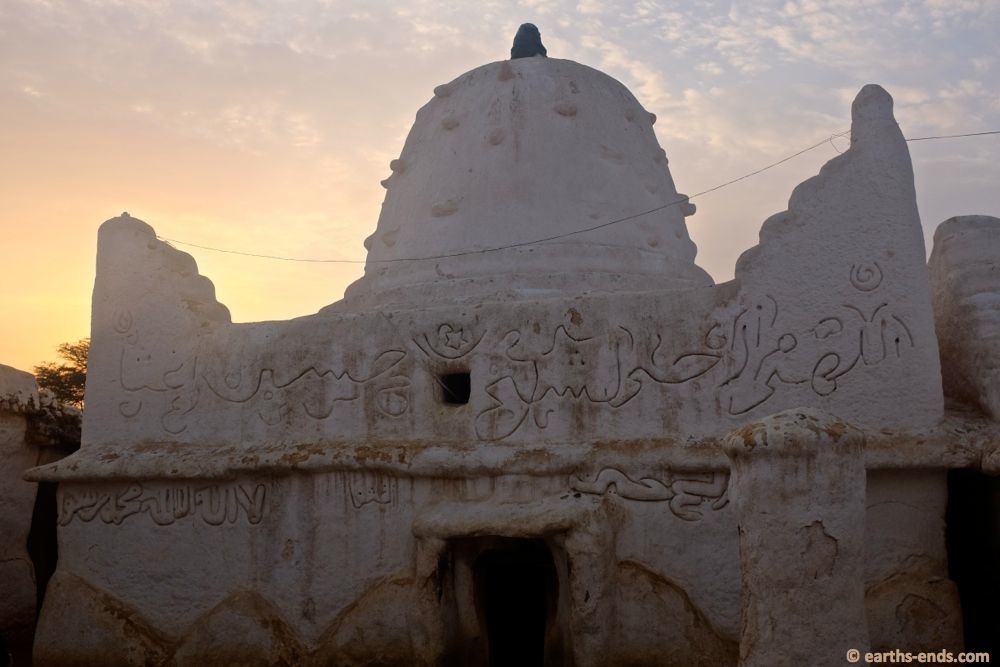
The tomb
We settled on USD18, still utterly ludicrous for Ethiopia, but a bit closer to reality and something we were more happy to pay. We put down our cots and entered our details in the tourist register. We were about the 50th and 51st people to visit that year, and being the end of July and the new year on the Ethipoian Calendar is in the middle of September (generally the 11th), that is a bit over 50 people for the whole year. That averages out to a bit less than 1 visitor every 6 days. You can now see why the tourist information building was abandoned.
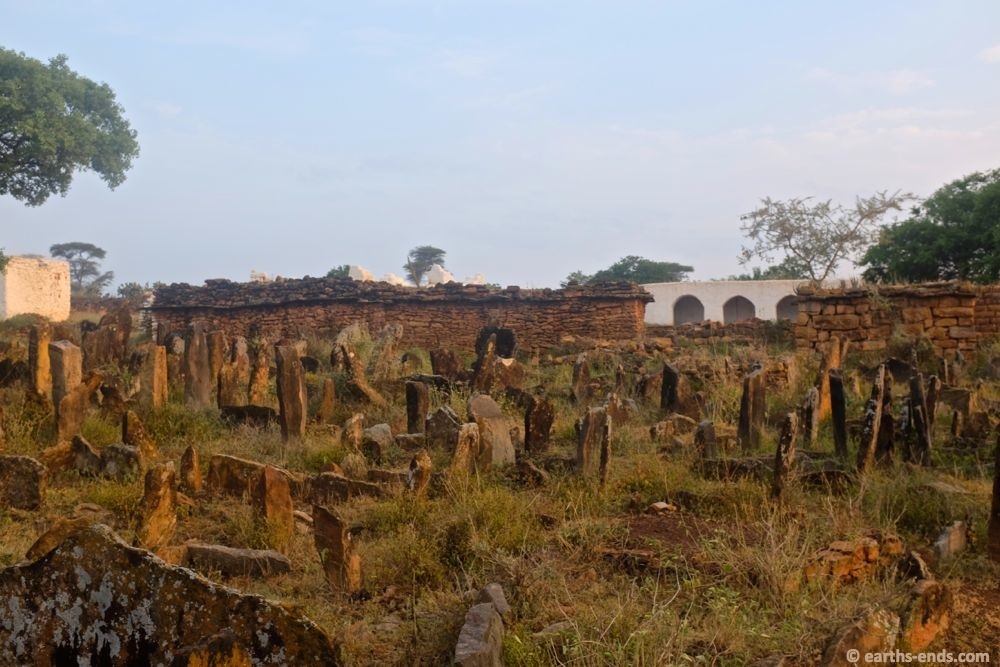
Graveyard out the back
Which is a shame, because the town of Sheik Hussein has a very unique tourist attraction in the mosque and shrine to Sheik Hussein, a muslim pilgrim who came through here in the 13th century and converted the populace to Islam. They might have just jumped the gun a little bit on building the tourist information building though. The town is still in the middle of nowhere, quite difficult to access and completely unserviced after all. No power. No water. No beer…
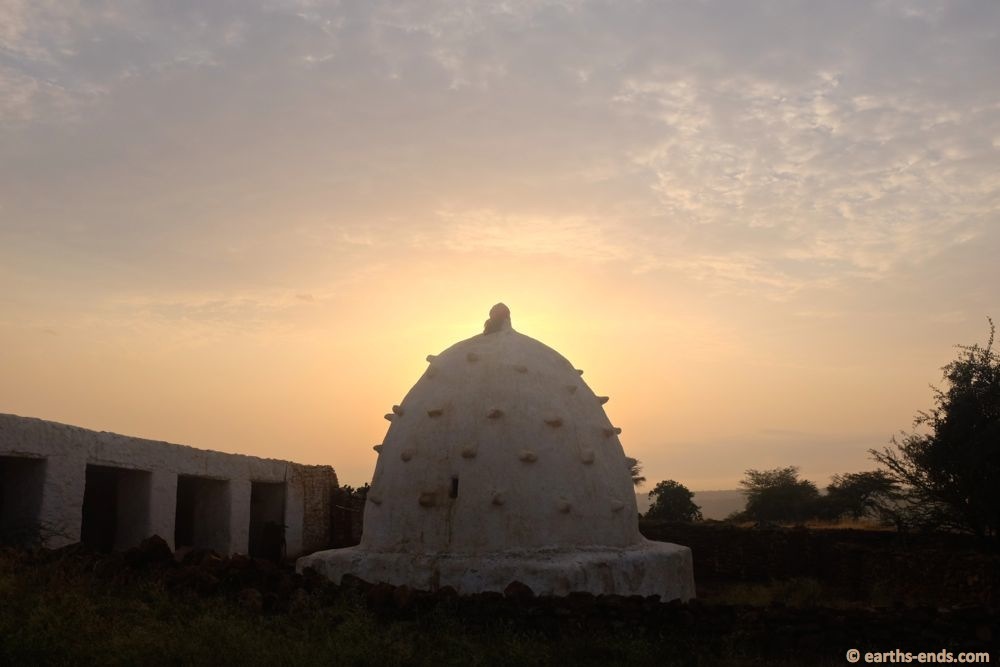
Another tomb
That night we had our first issues from the food. We had been warned of the predilection Ethiopian food has for upsetting ones stomach, but we had managed to avoid it to date. Until I woke up in the middle of the night, about 12 hours after eating lunch, and in a quite a nervous state. There was long drop toilet about 50m away in the corner of the compound and it was touch and go whether I would make it. Bad things happened in there. Bad bad things. I’m sure the next lot of tourists to come through Sheik Hussein will get charged much more than what we did to camp in the old tourist information building. Sorry about that.

View over the mosque. When the sun went down in the evening the town went completely dark. And then the mullah sang his nighttime call to prayer, and it echoed out over town. It was quite beautiful, especially compared to the usual call to prayer from mosques broadcast from a crap recording through a crap speaker at a hundred squillion decibel. That’s one benefit of having no electricity.
We were up early the following day to look around the mosque and shrine of Sheik Hussein. It was a very quiet and restful place, and beautiful in the early morning light. We were back at the bikes and packed and gone by 8. We had already attracted a huge crowd so skipped breakfast until we were about 10 minutes down the road where we found a quiet spot and had some crackers.

Inside the tourist information building. Coke hadn’t made it to Sheik Hussein yet but management bullshit somehow had. In the quest to provide good service, there was written up on the wall a mission statement, vision and values in addition to the 8 principles of good governance shown here. Now all they are missing is some tourists.
The riding that day was amazing. We climbed in and out of a number of beautiful sandstone canyons and saw basically no-one, which is near on impossible in any other part of Ethiopia. The 80-100km north of Sheik Hussein is probably one of the very few places in Ethiopia where you could comfortably wild camp with little risk of being found.
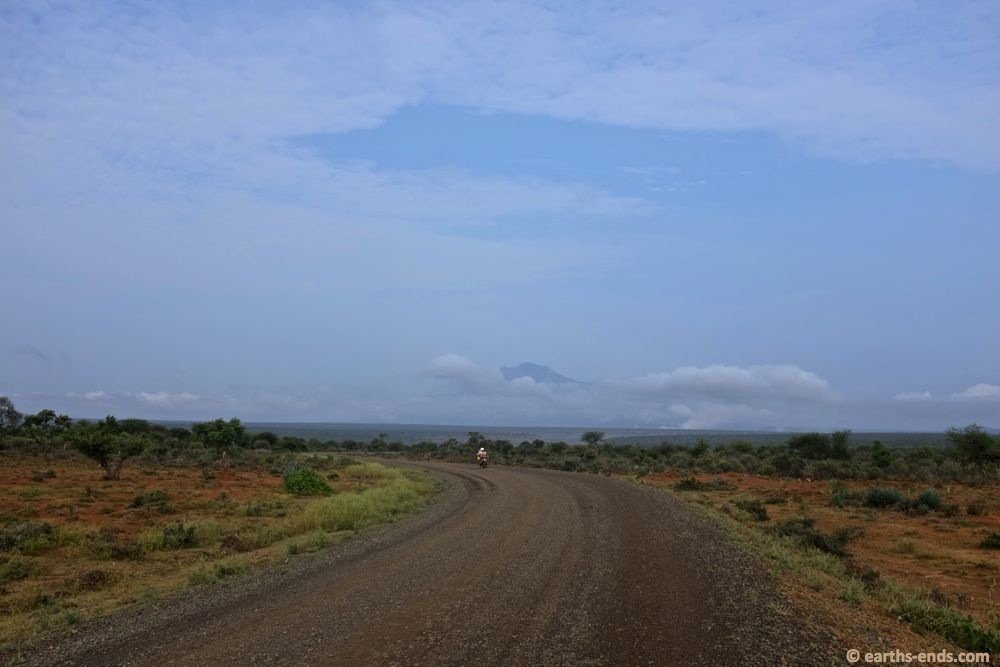
The start of the descent down into the canyons.
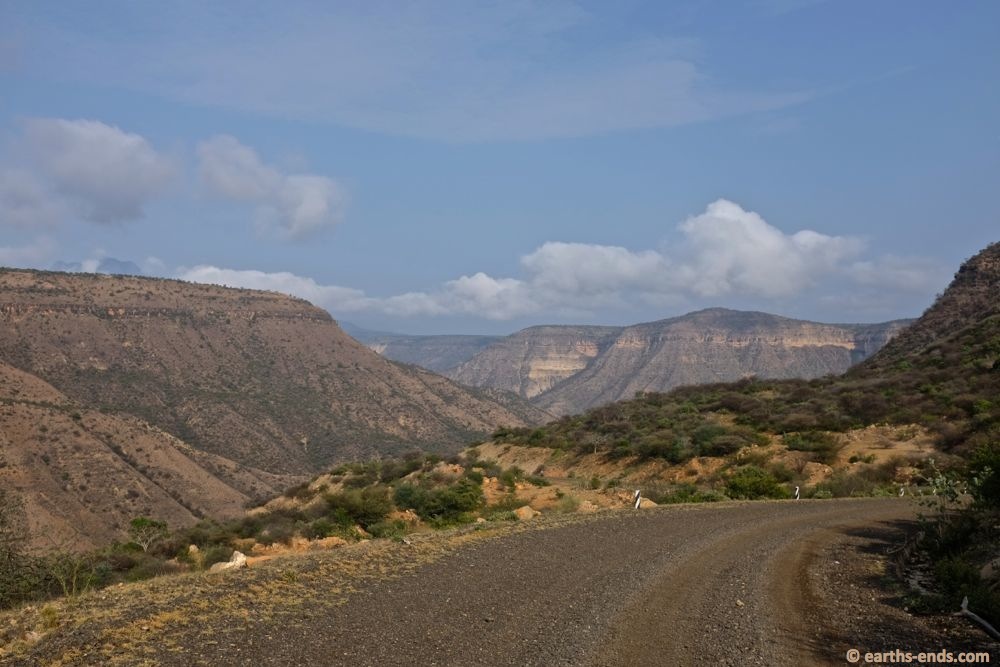
First proper views. We weren’t expecting this…
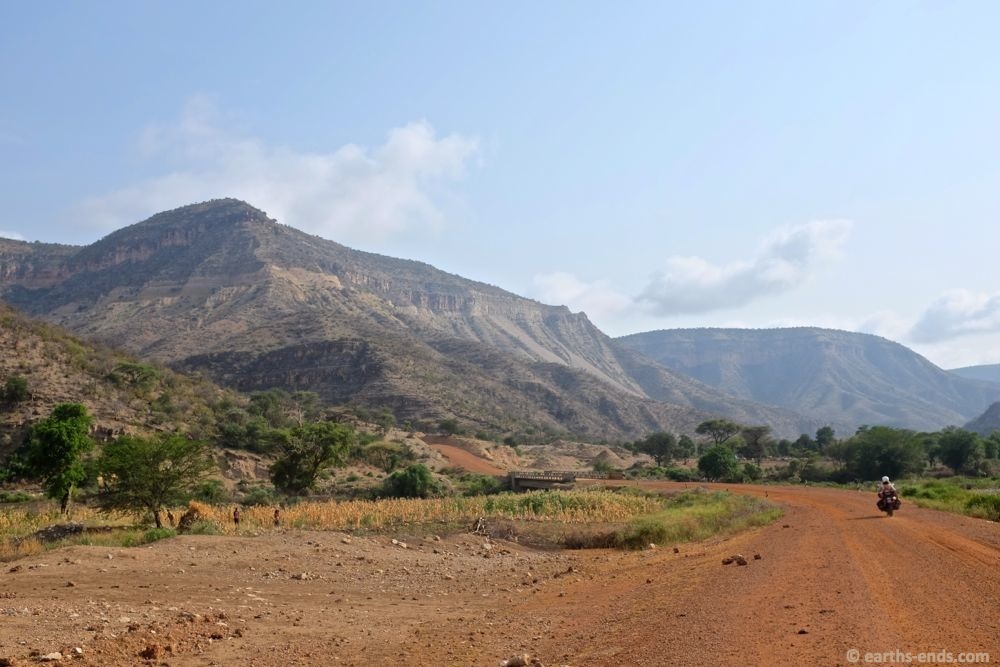
Down the bottom
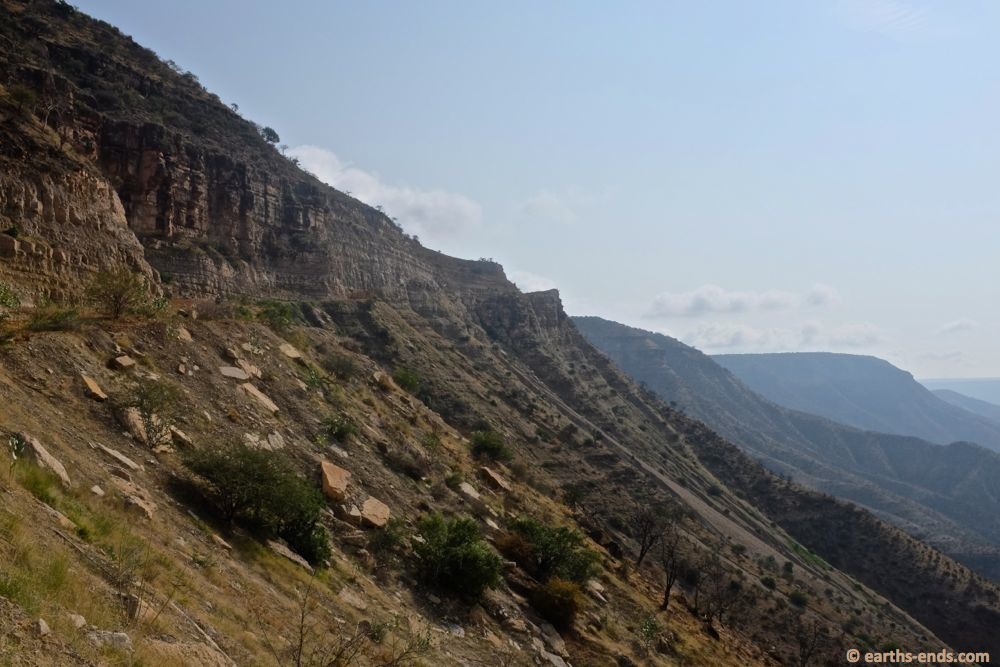
The climb out of the first canyon
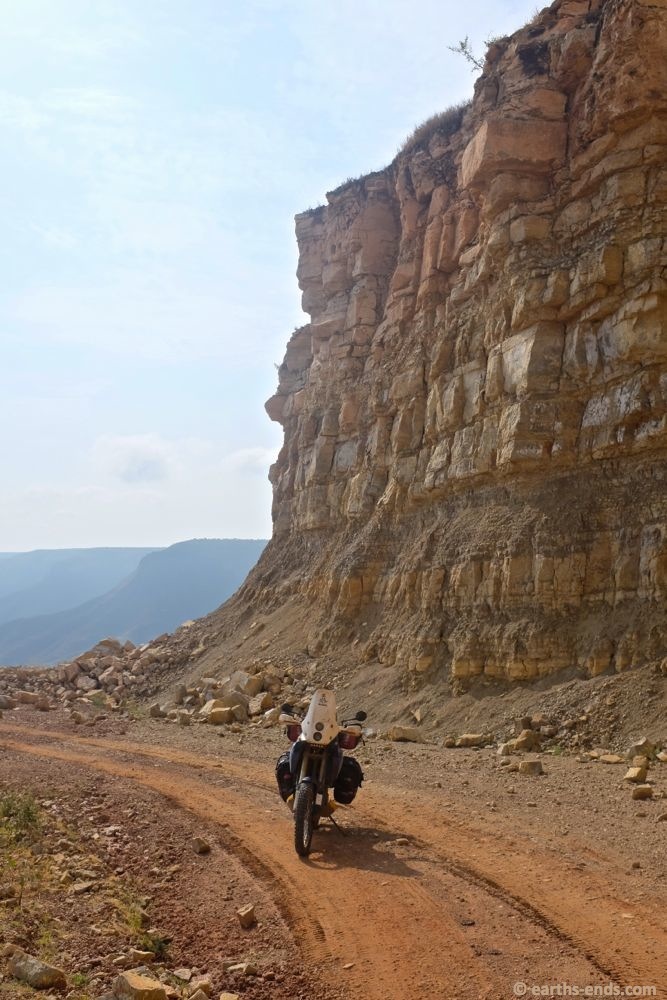
In one of the later canyons.
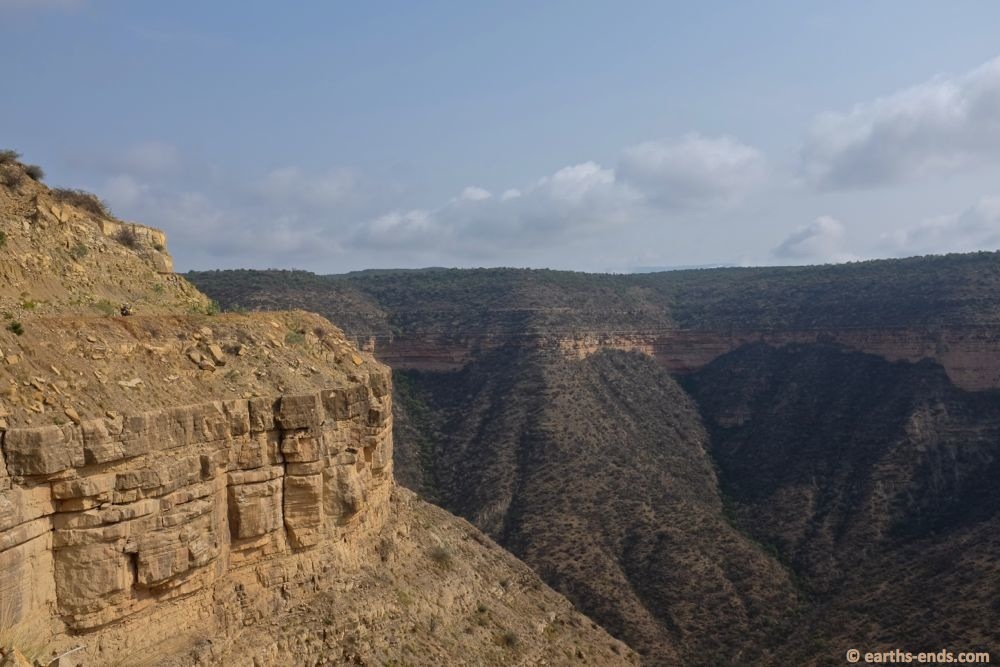
Views views views

Looking back at the last one. We crossed 5 I think.
Once we were out of the canyons though, the population just exploded. We had been looking for somewhere to rest and have a morning snack, but we were suddenly surrounded by endless villages and couldn’t stop without attracting a crowd of onlookers. So by early afternoon Tanya was getting quiet hangry.

Stopping for a snack. That’s chat growing on the hillside.
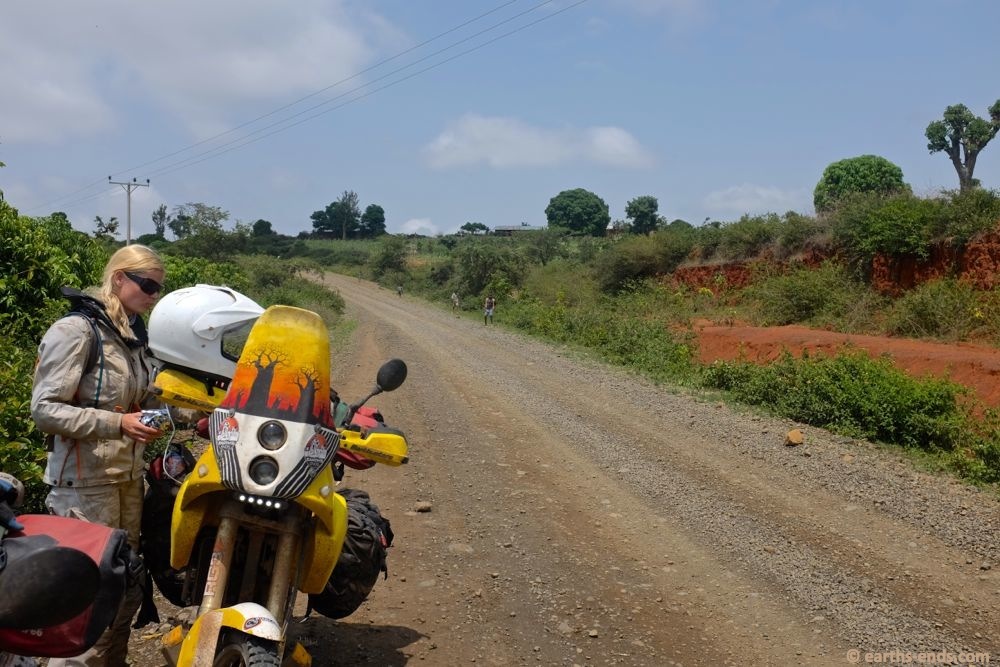
We’d had enough time to get our helmets off and had been spotted. Here come the kids running down the road…
We found a little roadside stall and got some food and tea for very little money, but were very quickly surrounded by people. Probably 100. While the atmosphere was really quite positive, the sheer amount of people clambering over each other to get a glance at us was intense. At first it was ok but with time we had more and more people getting closer and closer. We would have liked to rest a little longer but we had to go.

Lunch stop. Some food, that’s shiro (chickpea sauce) on the right, beans in front and potato at the back, all on injera.
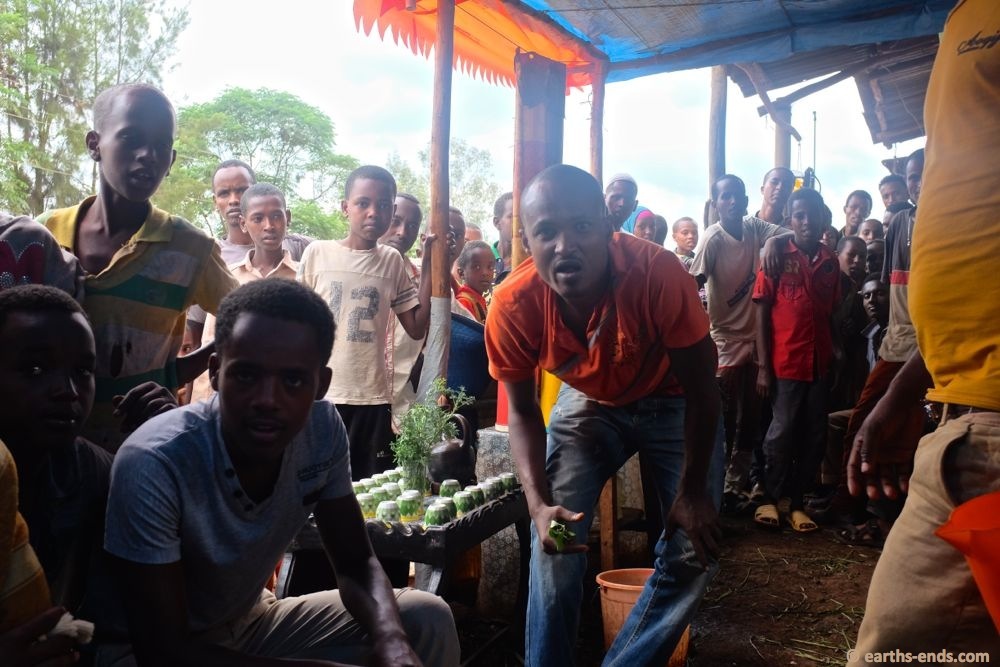
Trying to eat our lunch and this is what is staring at us… seriously. Everything is a spectacle in Ethiopia.

It was an intense, yet reasonably fun atmosphere. Everyone was so freakin excited to see faranji (Amharic for white man).

One guy wanted a photo, so Tanya gets out the camera, and then I had 4 guys jump all over me. We nearly all fell over, and everyone laughs.
We didn’t have gps maps or tracks so we were just following our nose and the compass north, which was pretty easy with so few road options but it got harder as we got closer to the tar and the amount of people just skyrocketed. We hit the main road and turned right towards Harar, but the tar gave little respite. While the riding was easier, the amount of animals and pedestrians meant we were travelling at much the same speed as on the gravel. Goats and donkeys were everywhere, and people would see the bikes and would run out onto the road shouting and pointing and trying to wave us down. Occasionally they would even try and grab at the bikes as we rode by.
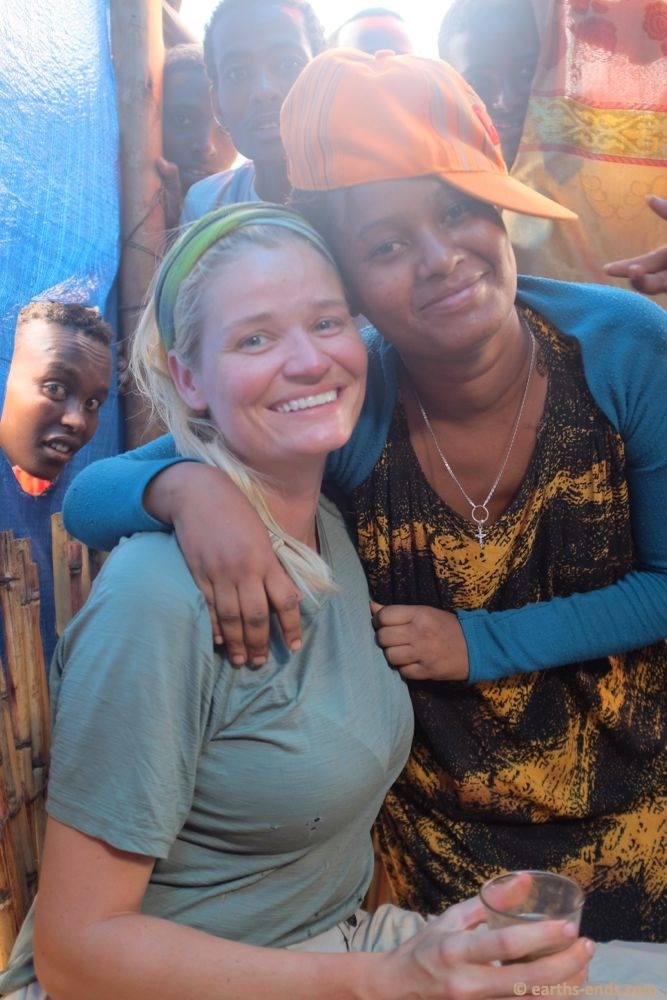
This chick wanted a photo with Tanya, but I think just to get a photo of her hat. The kid sticking his head through the wall was hilarious. There were a few holes and kids were always trying to steal a glance at us, but they were easy prey for the owner of the restaurant to whack.
At one stage, I came around the corner to see a large group of potholes, so swerved towards the left hand side of my lane (the centre of the road, Ethiopians drive on the right) to avoid the worst of them and got up on the pegs to absorb the rest. A small boy saw me and ran out onto the road screaming and pointing, causing me to swerve further left and into the oncoming lane. Thankfully there was no traffic coming (there are few cars in Ethiopia), however the enthusiastic running and screaming of the boy had excited his dog, who also ran out onto the road. And straight under my front wheel at about 60kph.
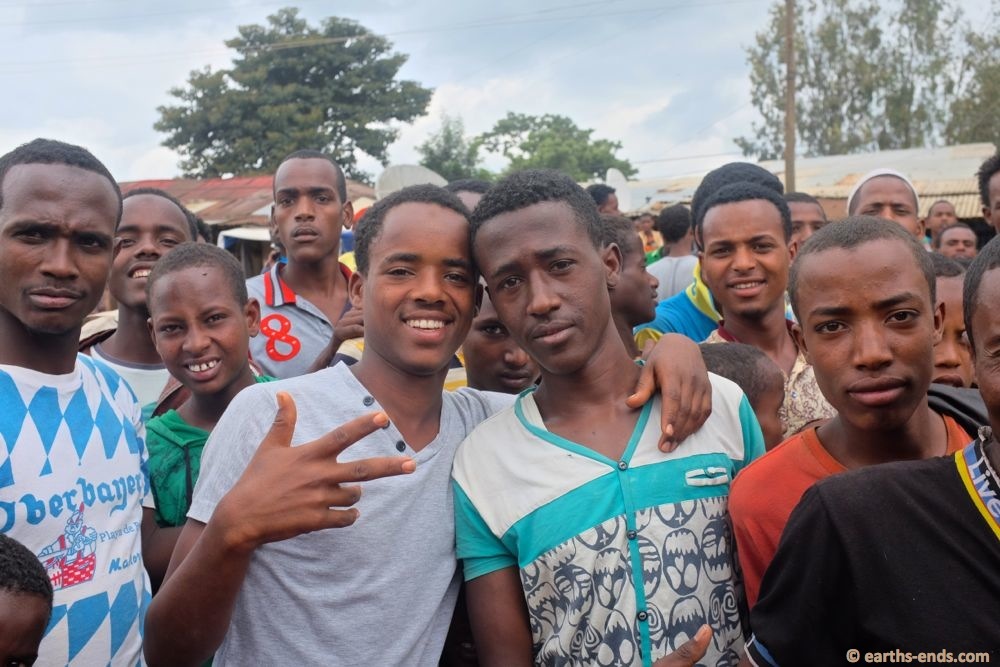
Getting ready to go. There were a few people who could speak some English. One guy kept repeating over and over “We appreciate you!”
Luckily the dog was a pretty common African mangy thing and wasn’t large, and as I was standing I could absorb the impact. The bars got jolted hard to the left and the front wheel bounced high as I hit; the rear wheel bucked up and left also, but I rode it out with heart pounding. If I was sitting I don’t know if I could have managed it. Poor Tan was 40m behind me and saw it all; the dog went under both wheels and was instantly dead. By the time she had ridden past, an onlooker had realised what had happened but we were gone. And we weren’t stopping. Sounds harsh but we had been warned by long term Ethiopian residents that you do not stop when you hit an animal unless you have to. The danger to you from the inevitable mob that forms is real.

Tan was popular
We later had a conversation with an expat resident in Addis Ababa about the cost of roadkill. While the locals will try and extort a foreigner for any amount of money they can get, the going rate for killing a goat or sheep is about USD50, a donkey is USD150, a cow is about USD350, horses are more again but dogs are free. He confirmed that the risk of mob violence if you kill an animal is real and suggested that tourists should just drive/ride on if they hit one. Most locals do the same if they can. He said if you hit a person, you definitely do not stop; you drive on to the next police station and declare it.

Just one part of the crowd that formed as we left lunch and headed to Harar. There were people everywhere.
We managed to find a fuel station with petrol which was handy as we were getting quite low. It was 550km since we had fueled up in Robe, and we had only seen about 3 petrol stations since. And all with no petrol to sell. We arrived in Harar with the sun getting low and our backs aching. We had been riding for 10 and a half hours and had managed 440kms. That is a real big day for Ethiopia.

Blog 45 by Tan- The Land That Time Forgot
After several unforgettable days of rigorous riding through the Turkana and Omo regions we somehow woke to find ourselves in a veritable haven in one of the most out of this world/time places. We had always planned to ride the east route of Turkana to Omorate but we had never expected to have anyone to call in on and certainly didn’t expect such wonderful hospitality. We had mentally readied ourselves for a sweltering night in a dodgy guesthouse in Omorate that even the perennially positive Lonely Planet travel writers had admitted to being a bit of a dump. However, a fateful meeting with an American motorbike enthusiast in Nairobi changed all that.
Caleb had been following our African exploits on ADVRider and recognised the bike I had ridden to the shop for a quick grocery run. After introducing me to his family who generously shouted me lunch he told me that we must stop in on his folks who are still living on the Omo River. Caleb and his brood had recently moved from Omo to Arusha, Tanzania and had told me that during his time there he had ridden his bike all over the place and could help us devise some interesting routes. It was a fantastic stroke of luck and an offer too good to refuse. We are shameless socialisers and love nothing more than hearing the stories of long time residents in the countries we are passing through. It has been firmly established now that our most memorable experiences have, more often than not, occurred at the dinner tables of many a new friend.

A welcome welcome
A week or so later, we were following the GPS bearing to their house through the hot and dusty plains of the Lower Omo Valley. The area in question looks like a land that time forgot and in many ways it had… at least until recently. At first, second and even third glance the area of the Omo looks utterly miserable. However, the more you saw, the more you started to question if it might not be a bit beautiful.
As I looked through the heat haze of the monotonous dusty landscape I remember thinking ‘why would anyone choose to live in such a place?’ We grew ever more curious as to what these American parents were like. We wondered what on Earth they were up to out here and why they were so inexplicably open to taking in two strangers on motorbikes based on a brief interaction with their son in a supermarket carpark?
Dick and Donna’s mission station was in stark contrast to the views around it. It is an oasis in a sea of dust. There were countless trees, constant shade and at that time it seemed rather like the most incredible place on Earth; an opinion strengthened by the appearance of coffee, pancakes and maple syrup on the breakfast table the next morning.

Sure this looks like Mick and Dick gasbagging the day away, however I am informed that any chatting that takes place in a shed and near to tools is in fact important verbal preparation for serious work. They prepared a lot that day.
Over the next couple of days we were riveted to the spot by Dick and Donna’s half a lifetimes’ worth of experience in the Omo Valley. Their stories were better than television and had they any entrepreneurial drive they could have left their tales at a cliffhanger and demanded payment to proceed. We would have enthusiastically thrown money at them.

A few of Dick’s windmills in action. More on these in the return to Omo blog
It eventuated that Dick and Donna were as curious about us as we were about them. Over the years they had found themselves playing the parts of both hosts and knights in shining armour to a string of travellers ranging from the intrepid to the downright crackpot. You see the Omo area, with its iconic tribal groups and inaccessible, wild frontier reputation, attracts some regular people but a disproportionate amount of the ‘crazies’. We were delighted to hear that we fell into the former group according to Dick’s discerning opinion. They had certainly met their share of the latter and given their good natures had always been there to help despite the misfortune these travellers seemed almost determined to invite upon themselves.
One such fellow included an eccentric young Isreali who upon arrival decided that the place and life of the Daasenech was so utopian he wanted to join in on all the fun. Which he did, by donning a loincloth (seriously) and hanging about, however, he didn’t endear himself to his new neighbours in ‘paradise’ (his words) as he would just help himself to peoples’ fruit and vegetables gardens before wandering off. The Daasenech approached Dick and Donna to question the presence of the strange food thieving white man. They were equally confused, yet confident it wouldn’t take long for the harsh realities of the Omo to penetrate his idealistic mental fog. Which it did. Then he left.
Another example were a European cycling couple who intended to cycle the Turkana route in plus 40 degree heat with all of 2l drinking water between them. It came as a surprise to them when Dick and Donna informed them of the significant flaw in their plan to replenish their water supplies at shops along the way – namely, the complete nonexistence of said shops.

The dammed/damned Omo River. At this time of year the water should be spilling over the banks inundating the land on either side to allow for planting. The Daasenech would come to learn that the annual flood is a thing of the past.
To add to the tale, this couple actually returned to Dick and Donna’s after getting ‘held up at gunpoint’. Donna was of the mindset that it was probably a misunderstanding more than anything. Most men in the area carry weapons from old rifles to the ubiquitous AK47, and it takes a bit of getting used to seeing such extreme weaponry casually slung over the shoulder of ¾ of adult males. The weapons are used for raiding/protecting against raids from opposing tribes rather than robberies. Donna seems to think the guys with the guns were probably just asking for something from the ‘rich foreigners’ who were understandably intimidated and started giving away their stuff. The guys with the guns would have been happy with this so continued asking, and in sight of the weapon’s the cyclists continued giving. In this part of the world if you don’t stand up for yourself you’re just meat in a grinder.

Two of Caleb’s wonderful kids were visiting their grandparents while we were there. Omo is a wonderful place to grow up and we were jealous of the fun and freedom the place affords them. Here they are on their mudslide into the Omo. Luckily the crocodiles that were once in the river in large numbers have been mostly shot out by the Daasenech to protect their beloved cows. We did see a tiny baby croc (<30cm) swimming there… but I don’t like his chances of growing big enough to cause a problem

And if you thought those kids were brave swimming near baby crocodiles in the Omo – they helped us clean our rank body armour too.

Dick’s sprawling shed was a great place to get some bike work done

First on the agenda was a tyre change. Behold the damage Turkana wrought on the Heidenau K60. People get a bit fanatical about these tyres but ours was a pretty disappointing relationship. We put it down to the stiffness of the compound and the weight of the bike. These tyres have a good reputation but generally on much heavier bikes. Curiously it performed the best it had ever performed off road while on the Turkana route despite it being at the end of its tyre life at that stage. We think it was due to having a bunch of extra weight on the back of the bike in the form of additional water, a spare tyre and the 10L of fuel in the secondary tank allowing for bagging with greater load. This tyre had 11,500km on it.
The next 2 days spent at Omo were blissful, yet an overlander’s work is never done. There was a bunch of small repairs to do to the bikes after their punishing exploits of late. My rear tyre was more than ready to be changed and Mick’s front fender required a repair after the metal mount cracked. In addition to this we discovered that my Safari tank’s aluminium brace had broken in half so Mick set about making a replacement and a spare for himself out of steel offcuts that Dick had laying about.
After breaking his clutch lever on Turkana we were now out of spares. With little chance of sourcing another lever in the short term Mick set about repairing the broken one using a piece of welding rod as a dowel. Proper replacements, as ever, were going to have to be sourced from South Africa. To minimise the chance of another breakage Mick cut the ends of all our levers. Something we should have done earlier, in retrospect. And there was a lot of tube patching to do as well. We were seriously doubting the quality of our patches and glue and started fantasising about doing some kind of ghetto tubeless conversion or stumbling across a big pile of money in Europe and doing it properly.

The fellas hard at work. Dick’s windmills were impressive and all the windmills were meticulously painted in the same Tiffany’s blue/green colour. It made for an impressive sight seeing the dozens and dozens of colour co-ordinated windmills lining the Omo. Splashes of vibrant colour on a mostly monotone landscape.

Coming up with a more permanent fix than the trailside duct tape repair job
All this work was punctuated by great company and wonderful home cooked meals. Each night was spent hearing Dick and Donna’s experiences as missionaries. It was a real eye opener for us meeting people so dedicated. These guys were so genuine, self sacrificing and pragmatic it really blew us away. We will never understand the dedication it takes to deal with the challenges and limitations of living in such a harsh and remote area all while working to help a tribe that doesn’t even have a word for ‘thank you’. The lives of the Daasenech people are so hard, and death and calamity such an intimate and frequent part of life that simple civilities like ‘please’ and ‘thank you’ just do not exist. No time for pleasantries when people are so busy dying or trying not to, I guess. Learning about the Daasenech and the work of Dick and Donna was fascinating but we’ll save all this for our return trip where we got to know them all a lot better.

Welding a new tank brace

The final product. He just did a copy of the original with some steel offcuts and padding was made from a buggered heavy duty tube…we had plenty of those.

The clutch lever repair – clever chicken this guy of mine
We were finally getting the energy together to tear ourselves away from Omo and even got close once or twice, before actually setting out. We’d been dreading both the giant dustbowl that constitutes the route to Omorate and our inevitable reintroduction to Mr Angry-M16 on the bridge over the Omo.
The construction of said bridge was good news for overlanders and locals alike. Dick and Donna used to keep a 4WD stored on the opposite side of the river, and whenever they did a shopping run to Addis they would have to transport everything across the river in their small dingy. This included everything they ever used to construct their houses and all the materials for their windmill project. Now however, it is just a matter of crossing the bridge. Life had become a little more convenient. But the completion of the much anticipated bridge was no simple process. Sure it could have been, but this is Omo and so it wasn’t.

No doubt about it – we were going to miss these guys

Before leaving we gave the kids the thrill of a ride on the DRs. If I remember correctly they said something along the lines of ‘wow this bike is infinitely superior to my father’s KTM500exc both in terms of power, handling and general aesthetics.’ Yeah… that is what they said.

Saying goodbye to Dick or ‘Diggy’ as he is known among the Daasenech.

Couldn’t wait to catch up with these guys again. If we knew what Ethiopia would throw are us (figuratively and very much literally) we might have spent 6 happy weeks there instead.
For some time the bridge stood partially completed. Its construction was started on one bank and built out towards the other, cantilevered with sandbags used as ballast. And there it stood for some time, waiting for what I am not sure… perhaps waiting for more money or materials or motivation or because those constructing it couldn’t believe it was actually happening themselves. Eventually the bags used for ballast degraded, the rains came and the sand washed away and the bridge toppled into the river. Ahh Africa….
And there it sat for some time until another company took on the task. This involved building a giant anchored gantry to haul up the submerged bridge. However its extended time in the river meant a small contingent of locals had to clear all the accumulated silt and branches burying the drowned bridge. That too took time as there aren’t all that many people who can swim in these parts and the guys worked with no more sophisticated equipment than their hands and a hose pipe extending above the water surface to breathe.

Leaving to return to Omorate. The dried stalks show old areas of cultivation. The year previous was one of the biggest and best annual floods in a long time so they were able to plant sorghum over a larger area. The Omo’s last gift to the Daasenech before the dam came on line.
The bridge had been finished for some months prior to our arrival but it was only very recently that sufficient work had been done on the foundations to allow vehicles to get up and on it. We had queried Dick and Donna about the origins and motivations of the bridge troll ‘Mr Angry-M16’ but they were at a loss and had never seen him there before. In anticipation of meeting him once more we crossed close together and sure enough he was waiting for us. No doubt he heard the DRs revving their guts out in the soft dust approaching the bridge. He came out of his hut/troll cave and tried to block us, this time dragging a log in front of our path and motioned for me to stop with his M16. Mick just waved and rode over it and so I did the same. He didn’t seem sufficiently bothered by our belligerence to actually do anything in response which was rather fortunate for us. ‘But it’s not like he’d shoot you’ I hear you say?? This is Omo, similar and stranger things have happened. We’ll save all that for the next Omo blog.
Our next destination was the small town of Jinka where we heading for no other reason than to gawk at members of the Mursi tribe. It was something that had us a bit conflicted. On one hand we were curious to see some members of this people group, probably the most iconic of the Lower Omo Valley, that practiced the rather extreme practices of lip stretching and ritual scarification. On the other hand we were also wary of being creepy voyeurs and a willing audience to a human zoo type situation.
And what did we do when faced with such a moral/ethical issue, you ask? We flipped a coin. But not just any coin, it was the ‘coin of destiny’ sourced from Mozambique that has never let us down in moments of decision making incapacitation like this. Coin said “visit the Mursi” so that is what we set about doing. If it was an unpleasant experience we could just jump on the bike and leave.

Lesson learnt with this diabolical dust bowl. This time I avoided the worst of it.

There was plenty dust to be had
But ‘coin of destiny’ aside we had come to the conclusion that paying people for the opportunity to meet them and take photos is hardly a crime against humanity. We had heard that some people disapproved of the interaction for the diluting affects it has on their culture, which is perhaps just a little condescending. Our Western sensitivities (borne of privilege and full bellies) would have us reject it outright as a demeaning practice. It is a shame that these sensitivities give us in the developed world superhuman ability to detect and describe (and post on Facebook) the wrongs and injustices in the world yet don’t do much in the way of presenting alternatives or even determining lesser evils. The harsh reality is that there are no sources of money for these people that keeps their traditions in tact and them free from exploitation. At least not at this stage anyway.
And call me callous but I think people posing for photos for a fee is the least of the tradition diluting forces at play at the moment. Road construction to serve the large cotton and sugar cane projects being built on their land that the government expects them to want to work at, not to mention the new dam that has halted the annual floods they depend on are the bigger issues here for the various tribal groups of the Omo Valley. With these projects their cultures will be irrevocably altered.

The new Gibb III dam near Sodo. This photo was taken by our mates Karin and Pete who have an excellent blog on their travels in Africa you should check out . The dam is a political hot potato and I wouldn’t recommend going and checking in out…especially at the moment…..especially not with a big camera
The dam is complete and has already denied the Omo Valley its annual flood for the first time. The roads are mid construction and will be tarred before we know it. The tide of change has come and the wave of development is about to crash. Sadly the Mursi, along with the Turkana, Dassenach and all other members of the Lower Omo Valley, will become the human flotsam; crushed by the wave rather than riding it, wherever it dumps them will be outside of their control and altogether unfamiliar.
We rode to Jinka, and found a hotel where my rear tyre went flat as we pulled up. We had no desire to fix it at that point so left it and sought out or first bit of Ethiopian food. Ethiopia was already proving to be a unique part of Africa. For one thing it has cuisine unlike most of Africa that seemed to consist of life sustaining carbohydrates and little else. Dinner was tibs, which is meat (generally goat) cooked in a sauce with berber spices, shiro, which is a chickpea puree, and injera, the slightly sour pancake which is unique to Ethiopia. It is made out of a local grain called tef which is fermented before it is baked, and substitutes for both serving plate and eating utensils. The injera is served on a large stainless steel plate, while the tibs and shiro comes out in bowls and is upended onto the injera by the waiter. A few teaspoons of berber spices will be dumped on one corner of the injera, and then it is a case of tearing off the injera, grabbing some meat and dipping it in the spice. All very unique and tasty.
Even after resolving our moral crisis over whether to visit the Mursi with a coin, the next morning over breakfast we continued our uhming and aghing as the prices we were quoted were silly expensive. A number of ‘official tour guides’ sought us out at the hotel after we arrived and quoted us $20 for a guide (apparently mandatory), $10 each and $1.50 per bike for entry to the Mago National Park, $10 each for the village entry, plus $5.50 for the scout. The village was a 125km round trip from Jinka on dirt roads and we told him we weren’t going to carry a tour guide on the back. ‘No problem’ he said, pay $35 and hire a motorbike for the day and he and the scout would ride on that. At those sorts of prices we just weren’t interested.
Just when we had decided we couldn’t justify the expense, another of the self proclaimed ‘official’ tour guides showed up to encourage us to go with him. However he completely discredited himself by lifting up his T shirt and stroking his ample beer belly like it was a perfectly normal thing to do. I couldn’t take my eyes off him rhythmically rubbing his guts as if summoning an intestinal genie while we sat down to our breakfast.
We were certainly not going to be taking a guide after that horror show. We packed some tubes and tyre irons on the bikes and decided to go alone. The dodgy tour guide mafia were set up at the turnoff to the park and tried to stop our progress. We were pretty sure they we just a pack of young fellas trying to take advantage of silly tourists. But if we were to meet up with them again I looked forward to explaining that rubbing one’s tubby guts over my breakfast is a rather poor marketing practice and one that had greatly influenced our decision making process.

Views as we approached the Mago national park. The government is doing a lot of road works in order to make life easier for the Mursi people… just kidding that is ridiculous – the reason for the construction is to service the huge (and controversial) sugar cane and cotton plantations that are going in following the damming of the Omo. Tribes of the Omo’s loss is foreign multinationals’ gain it appears.
The Mago national park was on the GPS so we headed for it. On the way we passed something that may have been the entrance to the park but it was ungated and unmanned so we just rode on. Turns out the GPS point we were navigating to was actually the checkpoint where you pick up your mandatory scout. So it seems we had entered the park on the sly and we could now add park officers to the list of people we had disappointed that day.

Our first photo for cash solicitation. She looks about as comfortable with the exchange as we felt

Miscellaneous objects placed on heads to photographic appeal
We didn’t mind taking a scout with us as they looked like nice enough fellows and the price wasn’t ridiculous. We put old mate and with his rifle on the back of Mick’s bike and he seemed happy despite the lack of pillion foot pegs. We rode further into the park where the scenery and pleasantness of the ride made the trip worthwhile for the views alone. We spotted a couple of boys painted white and yellow standing by the road side waiting for us to stop and take photos. We waved but rode onwards, not being comfortable with the notion of paying to photos just yet.

This practice is said to be a show of the bravery, tenacity and ability to endure pain of the women. All key requirements to being a wife in these parts.
We came upon the village and parked the bikes while feeling slightly nervous. We have come across a lot of different people groups in Africa but each occasion prior to this had just happened during the course of our travels. This, in contrast, was commercial and contrived and we felt unsure of ourselves. I guess we were on the defensive from the start, expecting rude and incessant cash demands, begging and maybe even some hostility based on some of the bad experiences people had shared. However the people there seemed pretty happy to see us and waved and smiled somewhat reservedly.

The head lady without her lip plate. The lip is cut and stretched over time however it is also requires the removal of the four middle teeth of the lower jaw in order for the plate to sit in position. Ever the engineer, Mick was disturbed by the lack of a engineering solution to the lip plate interfering with teeth problem ‘why knockout the teeth to accommodate the plate when they could cut out a piece of the plate to accommodate the teeth?’
Being on the bikes is always an icebreaker and from the start they seemed mildly interested in us. It all seemed pretty laid back actually. We shook hands with the head boss man of the place and gave him the required cash. We then went for a walk through the small collection of huts of what looked like a family unit rather than a village proper. The price per photo is a very well established 5 birr (25 cents). And these people aren’t silly; they count camera clicks. If they suspect you’ve taken more than the one photo they will want to go back through your digital screen to verify. It made us feel a bit embarrassed and sorry the way they tried to make themselves look more appealing for photos by wearing different things on their heads and doing different poses, all trying to look as exotic as possible. To me it looked like they were wearing a random assortment of paraphernalia aimed to make themselves look more ‘authentically Mursi’ to people, that wouldn’t have the faintest idea of what that should look like.

It seems not all women make the decision to engage in the practice these days. I couldn’t help but wonder the reason. Do they perhaps understand their way of life is about to be changed? That their young girls may need to engage with outer world more than ever and the extreme practice of lip stretching would be an impediment to this? Are the young girls themselves not wanting to do it? Is it the young men not wanting a wife who has done the practice? I would never know. ‘Photo five birr’ is the only English the girl spoke.
Yep, it felt a bit shit but it was all pretty calm… but a little shit. Especially the way the young kids worked hard to get their photos taken. I couldn’t help but wonder what it felt like for them when the tall strangely dressed whitey woman declined to take their photo for some reason unknown… not impressive enough perhaps? I felt like the nasty judge from American Idol… ‘that’s a no from me’; quickly dismissing someone’s efforts and leaving them to ruminate on their shortcomings while moving on with the show. What I really hoped, and was inclined to believe, was that they actually don’t give much of a shit about what we think and that we are just a convenient way to gather a bit of cash with minimal time and effort.

The lip plates can get between 6 and 7 inches in diameter.

With and without. Some Mursi women have undergone plastic surgery (offered for free by visiting foreign surgeons) to restore their lips but I can’t imagine it is that common to do so.
It got quite busy with everyone wanting photos taken of them yet it wasn’t out of control. The head lady actually seemed very friendly. There was one young girl who got really pushy but the scout told her off for it. The scout was a fun little addition to the crew actually. We got the impression he was feeling happy with his promotion to head minder of the tourists given the absence of the tour guide. We came to learn there are some striking divisions between the different ethnic groups in Ethiopia, with every ‘non-Omo’ group thinking themselves far superior to the 16 ‘primitive’ groups of the Lower Omo Valley. It is quite probable the local scout is not treated with all that much regard by the tour guides who are almost exclusively from the highlands. He kept things calm and reasonable as time passed on and people become increasing worried about missing out on photos at our departure.

Young girls whose lips are already quite stretched. Most of the women we saw also stretch the ear lobes and practice ritual scarification.

As with the western world the males don’t go to quite the same extremes in the pursuit of beauty. Body paint it common amongst many of the Lower Omo Valley tribes.
The head lady came up to us and thanked us for coming. We were reassured to observe that we seemed to them more of a mild curiosity than a nuisance, and they appeared to quickly get back to doing what they were doing before we arrived. I hoped they viewed us in the same way we might view a pizza delivery guy back home; a stranger invited to our doorstep but no further, and only because we want what he has brought; someone whose face and presence is soon forgotten when what we seek is in our possession.

This girl had stretched ear lobes but had not done her lips nor did she have any visible scars. It must be a personal choice I suppose.

Michael with the head lady

The dwellings of the Mursi. They have few modern conveniences beyond large plastic containers for water, a couple of small plastic buckets for washing and battery powered flashlights.
Really we should have used the bikes to bridge the divide between us as we had so many times before by showing off the GPS, letting some kids sit on the bike and taking people for short rides… but at the time we felt too shy. It was business – no time to play it felt. I regret not having done it anyway.

This girl approached for a photo but really didn’t seem like she wanted one and I felt really shit taking it.

A young man. There were few about. It seemed they were seeing to their cattle.
On the whole it was a decent experience, as it seemed to us that this little family group still had control on what they were doing letting in tourists. It is not the same everywhere by the sounds of things. Abundant tourist dollars can create huge disruptions in some of these villages and has contributed to the rise in alcohol consumption (helped by improved roads too) and all its associated ills. We were utterly flabbergasted and appalled to learn that foreign sex tourists are coming to Jinka to get their ‘ethnic’ jollies in increasing frequency. As if they didn’t have enough to deal with already, they had to face a bunch of fetishising dirty old perverts too.

Our scout back at his post. He seemed happy on the back of the bike despite having missed out on his usual 4WD air conditioned comfort.
We then dropped off our scout and left him with a nice tip and some chewing tobacco as a gift which we carry as an emergency ice breaker (handy around these parts). Now it was time to leave the park and pay our dues at the gate. Luckily they weren’t upset at us for entering without paying our fees and we quickly sorted things out.
The next morning we were half expecting a confrontation from the local tour guide mafia but it never came. We never did figure out if it was officially required that you had a tour guide or not… whatever. After getting some cash from the ATM we fuelled up and left town. Between Jinka and Key Afar we passed many members of the Hamer tribe heading to and from the market. Both men and women were decked out and resplendent in their traditional dress. We got plenty of waves and even more stunned expressions, but in ‘on bike – must ride’ mode we never stopped for photos unfortunately. So once again we’ve had to jag some pictures from the net to show them.

Views approaching Konso
The Hamer tribe are famous in the area for their bull jumping ceremony (the Karo tribe also does this) and their women. The Hamer women, are said to be the most attractive of the area’s tribal groups and are referred to as the ‘black Venus’. But unfortunately for Mick it seems the black Venus types don’t do the market run. All we saw were dozens of old duck’s demonstrating the physical effects of decades of hard labour under the unassailable forces of gravity in a punishing and bra scarce landscape.
The Hamer are certainly an interesting group. They number about 20,000 and like most of the tribes in the area, life revolves around their cattle. They are so enamored with their bovines that their local language has 27 words to describe the colour of a cow. It comes as little surprise then that they don’t mind dying for them either. We heard that while we were there some serious stoushes between government forces and the Hamer were taking place. The government has been trying to restrict the grazing territory of the Hamer. Thems fighting words to the Hamer. I assume the reason is to mitigate against tribal confrontation but you never know with the Ethiopian government; it may just be a way to keep them under heel and extricate land for their own purposes. These tribes, flush with weapons from the war zone of nearby Sudan, are emboldened by crazed cow love. The government forces, made up of outsiders/highlanders who tend to avoid confrontation with the local tribes as much as possible, are no match for them in this instance.

A young Hamer woman taken from the net. Searching for this pic online gave further support for paying the locals for photos. There is a huge amount of these types of photos for sale online. Ok for foreigners to make money from the photos (many hundreds/thousands of dollars) yet demeaning and ‘wrong’ to pay the tribal groups for photos….. can’t deny that we can be a bit full of shit in the developed world sometimes. Especially when offering opinions on what these groups we know nothing about should or shouldn’t be doing
But it is to see the bull jumping ceremony that tourists flock to Hamer villages, primarily Konso. This lucrative flocking has not gone unnoticed by the local government who now set the times and dates of the bull jumping for ease of profit extraction. In order to marry, a young fella needs to get naked and jump a row of about 15 cows that have been covered in butter and cowshit to make them extra slippery. If the fellow falls while trying to leap/run across them, he is denied the right to marry and is beaten by the women watching for his troubles. If he succeeds he is elevated in status, scores the right to a missus and gets to beat some females relatives bloody much to their approval. Female family members will beg the successful jumper beat them with whips and sticks until the point of bleeding. Screaming is not permitted. Often the women taunt and encourage him to strike harder.
The scars then go become thing of pride, status and insurance for the women. If these women go on to experience hardship (which lets face it is inevitable) it is expected that the fellas who inflicted the scars will remember what a swell time was had at his initiation and look out for them, thus honouring the blood debt. Try romanticise that one, friends.

They had some impressive hair indeed. Another random internet pic.
As the bull jumping schedule is now tightly controlled by the government, tourists can sit in the stands (literally) of a government controlled initiation ceremony or they may be offered some secret, faux bull jumping ‘performance’ on the sly. This is likely to be performed by any ol’ naked dude jumping over a couple of hastily organised cows. At the very least you may be offered a chance to watch women get beaten bloody with sticks. Outside of its real context and without its traditional meaning, such a practice I would say is pretty messed up. The Estonian couple Magnus and Karina who have a phenomenal RR on ADVRider described their not so nice experience of this . That is why we opted not to drop in one of these ‘ceremonies’. Paying for photos is one thing, paying to watch women get beaten is another. Plus we weren’t there on bull-jumping day, which made the decision even easier.
We rode through to Konso and eventually found somewhere to eat. In full ignorant tourist fashion we still hadn’t learned the names of any Ethiopian foods so once again we just walked into a restaurant and made eating motions and then nodded our heads at the first thing they offered. This Russian roulette method of ordering had been going all right so far but we had resolved to learn the names of some foods at some stage. Either that or complete the picture by yelling what we wanted in English increasing louder. We were served what we thought was burnt goat… or maybe beef. Either way it tasted good and filled the belly and before we knew it we were on the road again, this time heading for Yabello.

Our tasty lunch of roast meat, injera and bread with some spicy horseradish type sauce

On the way to Yabello
While at the restaurant I befriended an Ethiopian family who were pushing their shy and highly embarrassed kids to come and say hello to us. Seeing the kids’ torment I decided to make the first move and approached and said hello. It was a good thing too because we ended up running into the family twice more and in different towns, each time being greeted like long lost family.

More views

If you stop in Ethiopia… they come for you

Mick tending to our daily flat tyre

Another failed patch
We made it about 45km out of town before I got yet another flat tyre. We were thoroughly shitted with patching and changing tubes by this time. We had a couple of things working against us in this regard. Firstly, we were running heavy duty tubes with slime. I don’t know if there is something about the slime but they just don’t seem to hold a patch the way un-slimed tubes do. Secondly, our crappy Chinese patches were far too crappy for the job. They were simply delaminating to nothingness. And finally, I have to concede, looking at one of these last blown patches my prep work was a little underwhelming. We whipped out the old tube and broke out the new Vee Rubber one we had purchased for a fortune in Jinka. It was smaller than what we like to run but it was all we had at the time until we arranged to repair the couple tubes we had.

We soon had a cheer squad of road workers and the family we had earlier befriended

Riding till sundown – it was hard to gauge how far you could expect to travel in a day in Ethiopia. We soon learned that a 300km day was highly ambitious.
While changing the tyre we had a bunch of young Ethiopian surveyors working on the road show up to lend a hand. With no help needed they instead stayed to watch and offer encouragement. We were soon joined by family we had befriended earlier in the day who also were on hand for moral support. Once it was done we hit the road again, where we once again came across a road busily under construction by the Chinese. It was a nice bit of riding and we arrived in town with enough light to find an acceptable hotel (with a very unacceptable ablutions block) for $7.50. Next up – a foray into the Bale Mountains.

Blog 44 by Mick: Lake Turkana Route PART 2 – North into the Never Never
We hit the road after a big breakfast from the campsite and headed north. Our plan was to camp that evening in the Siliboi National Park about 180km north, meaning our relaxed start that morning wasn’t of too much concern. The track north of Loiyangalani was free of the sharp basalt rocks we had ridden on into town the afternoon previous and in decent enough condition for easy gravel riding.

The road north that morning, nice gravel and nice views

Tan waving at some herders, and some road works in action… not sure what the go was here but it seemed strange, we hadn’t seen any roadworks since the windfarm construction camp well south of Loiyangalani, so why here? I wander if they are preparing for some construction…

A kid from the Turkana tribe
About an hour north of town we came across an old guy on the side of the road who waved us down. It was tough, desolate country and pretty hot, even for mid morning, so we stopped to see if he was ok. He asked us for a ride into the next town which we had to politely decline; the bikes were already quite heavy with fuel and water and the riding was getting more and more technical, so we weren’t comfortable with the idea of another 70kg on the back of a bike. He seemed to understand.

Northwards!

Wide open spaces

Rocks and rocks and little else out here
He had obviously been walking for a long way as when he pointed to his foot, we saw a significant open wound where his plastic sandals had rubbed through his heal. He had been trying to cover it with a black plastic bag, but it was still dirty and inflamed, and looked pretty damn sore. I didn’t blame him for waving us down and asking for a ride. Tan whipped out our first aid kit and cleaned it up with some betadine and covered it with a good sized bandaid to help with the rubbing of his plastic sandals. We filled up his water bottle which was empty, gave him some peanuts to snack on, left him with some XL bandaids and betadine cleaning wipes and bid him farewell. He seemed pretty happy in the end and wandered off into the desert taking a short cut walking trail to the next town.

I cant quite remember what I was doing under Tans bike – whatever it was it was worth a look anyway…

North of Gusi village, road was starting to get rougher

There were a few dry river beds to cross
We rode on and up a small rocky climb onto a plain and a kilometer or 2 onwards when I realised we had missed a turn to the north. I noticed a small village on the GPS a kilometer ahead which we decided to go and see. We had left that morning with enough water for the day and some extra for camping, and after giving away a litre and a bit we were wanting to replenish our stores. There was a shop on the GPS in the upcoming village and even black market fuel apparently.

Fun riding here. Was a little tricker than what it could have been as our pressures were still very high for the rocks.
 Bluey on the basalt plains. The heat coming off the rocks was astounding.
Bluey on the basalt plains. The heat coming off the rocks was astounding.

Tan using our cheap umbrella on a snack stop. We had been told there was no shade on the route and the sun exposure can be extreme, which it certainly is. So we got a cheap umbrella in Nairobi as mobile shade.
The village was a tiny and dusty affair, and the shop was little more than a handful of cans of pilchards and bully beef stacked in the corner of a hut. There was no bottled water, although there was a bore we could have used but decided against as Tan can get quite sensitive to the minerals in ground water. Out of interest I had a quick look and asked if there was fuel available as suggested, which there wasn’t; take that onboard any potential Turkana riders out there – there could well be fuel on the route but get current info before you go. Don’t implicitly trust T4A, and people does not necessarily equal fuel.

Unfortunately the wind made its use problematic!

Rocks, as far as you can see.

At one stage, I started riding the stock/walking trails s they were less rocky, but we got separated. I ended up in the valley while tan stayed on the road and ended up on the ridge. We could still talk on our intercom but the separation seemed like an unnecessary risk, so I rode up to meet her.
We back tracked the 3km to the missed turn and headed north. It was obvious the trail saw little traffic and even less maintenance. We crossed a few dry riverbeds and ended up back on more of the basalt lava fields we had seen for the first time yesterday as we got to the edge of the lake. It was pretty easy riding but for the weather; on the open plains we were exposed to the elements. With the sun blaring down, heat reflecting of the rocks and the dry wind we were hot and drinking a lot.

Was easy riding thankfully, just hold some momentum and miss the big rocks and all is well

Getting closer to Siliboi NP.

The gate where wallets are broken and tears flow free!
After 3 hours of 40kph riding in the midday heat, we got to the Siliboi NP gate in the early afternoon. The rangers at the gate were friendly and excited to see someone other than their workmates, but it was like a slap to the face when we saw the prices. For the two of us to enter the park with our bikes and camp for the night was going to cost USD97! Pretty astronomical, especially for such a remote and rarely visited park… why is some stuff in Africa so expensive? We considered turning back and going around the park but with our water consumption for the day being so high, we were now down to about two litres each. We wouldn’t make it north to Omorate without a top up. Plus the idea of a shower was nice…

The NP is famous for paleontologists and is the site of the earliest hominid fossils in the world.

Sitting down after a day in the saddle.

Camping in the NP. We found a spot to ourselves. Being Lake Turkana, there are plenty of those. You’ve got the entire place to yourself!
So we closed our eyes and with considerable pain we opened our wallet, and entered the park. At park HQ we were able to get a warm Fanta (only Fanta, nothing else, just Fanta. Must be the least favourite amongst the park rangers) from the canteen and top up our water from a rain water tank. We spoke to the rangers and were pretty shocked to hear the campgrounds have no facilities at all, which simultaneously destroyed our dreams of a cool shower and burnt that hole in my wallet just a little deeper. So instead of riding the 15-20km to the campground and back, I asked if we could just camp on the lakeside near HQ at a place called Crocodile Corner? Sure they said, just be careful of the hippos and crocodiles… oh and it gets windy… real windy.

Sunset at Crocodile Corner

A flamingo trying its gangly best to take flight

Views from our camp. Despite the cost we really enjoyed the solitude and uniqueness of camping with all the wildlife around us.
We set up camp with zebra, gazelle and hartabeest on the plains behind us, and flamingos in the water in front of us. The hippo warning wasn’t just bluster either; when the sun started setting we heard the hippos belching in the water 50m from us. We went to bed shortly after sundown in sweltering stillness and a few hours later we were woken when the wind tried to rip the tent from the ground and throw us in the lake. I got out, after being warned about lions and hyenas and crocodiles and hippos and everything else, and set up the bikes as wind breaks which helped a little but not enough to avoid another restless night’s sleep.

Camp the next morning after moving the windbreaks a bit. Zebra and Gazelle in the background.

Rocky riding the next day… the rocks were very loose making these little ascents trickier than they look

Tan managed fine though
We woke the next morning covered in sand carried in by the wind, and after a coffee and a small breakfast of salami and crackers we were riding again out past park HQ and heading north. It was going to be a really tough and long day on the bike, travelling about 210km in proper off road conditions and border formalities to boot. Soon we were riding very rocky trails in the park before hitting sand where we had the first stack of the trip. Tan got caught in some deep ruts in hot and soft sand. The riding was tricky in places but most of it was manageable, however I could definitely feel the extra weight as I was carrying more fuel, more water and a tyre.

Drink stop. It was hot riding.

First signs of any humanity in quite a while – some cows

Into a rock garden
Further north we ended up on a ridge which afforded some great views of the lake. The rocky decent that followed wasn’t so great though. We could see it from the top of the ridge and it stretched to near the lake edge, and was fist sized rocks and bigger most of the way. Tan managed the decent after a few nerve racking moments, but with more weight on my bike on the steepest section I got knocked off the trail dropped it and managed to break my clutch lever. At the very least it gave us the chance to use our cheap $4 umbrella that we brought exactly for situations like this.

Tan was a bit too tentative and dropped it

Another dry river crossing. It was close to midday by now and hot and the sand was soft and loose.

You might have noticed the roost in the previous photo… well this is the result.
At the northern border of the park we saw people for the first time that day, some pastoralists walking with their cattle. We rode onwards with the rocks getting less and less frequent and the sand getting deeper. We made it into Illeret, the last settlement before the border, where I had thoughts of changing Tanya’s rear tyre. We had heard that the trails north of here get sandier, and Tanya was worried on her very worn K60 rear tyre.

Getting the bike out took a bit of a push

Views of the lake from the ridge line. Descent to come…

Lots of decent sized loose rocks made for a tricky descent
But that didn’t happen, as Illeret, as our diary entry for the day graphically notes, is “quite the miserable shit hole”. When looking for the road through town we mistakenly rode into a compound and were set upon by some rather drunk and poorly dressed men. Bear in mind it was about 11:40am. One in particular was so hammered he was struggling to speak, yet he still demanded to see our passports and was quite forceful with his questioning and finger pointing.

Coming in to Illeret. Not too sure why this photo has done this, looks like its exported with an error… shame. Oh well it is uploaded now.
“Where are you going?!” he slurred.
“Banyafort then Omorate, Ethiopia”
“You cannot! there is no borderpost! You must go to Moyale!” he shouted.
“No we don’t, we can cross here, we spoke to immigration in Nairobi and we know we can cross here”
“Give me your passport!” he demanded.
“Fuck off! Who the fuck are you?”
That may not have been the wisest move in retrospect, but by this stage in our travels we had been in Africa for nearly a year, and we get asked to show our passports to all sorts of people. Many of these people have no idea at all what they are looking at, and it is difficult to determine who has the authority to ask for these things and who is just curious/demanding/showing off to their friends. And this guy was so drunk, unkept and demanding he pushed a few of my buttons.
“I am Police!”
“Well then show me your fucking identification! You say you’re police? Prove it!”
Which he then did. This wasn’t going particularly well for me; in fact, fair to say this was going rather poorly.
“Now give me your passport!”
“I’ll show it to you, but I am not giving it to you”
I showed him our passports, including our visa for Ethiopia and our exit stamp from Nairobi Immigration, but I held them firmly in both hands and would not let him take them when he tried. The fella was so drunk he couldn’t walk straight, there was no way I was giving him the passports. He asked us to get off the bikes, which I said we would not, and then he said he would get his boss.
“Good, go and get your boss”
Thankfully his boss was reasonable, and very importantly, he was also sober. I showed him we had the correct visas and exit stamps and that we were going to Omorate. He looked at our passports, explained that he needed to record our passage out of Kenya in his register, which we then signed. I apologised for him needing to come from his office but said if his men hadn’t been so aggressive it wouldn’t have been a problem. He understood and bid us farewell. It was a 5 minute formality that had turned into a 15 minute confrontation, all due to booze and pride.

Stopping for lunch on the border

This Daasenech man and his 3 daughters walked up. He didn’t beg or anything but gratefully accepted some tuna and crackers when we offered. We like to share food in these sort of situations. It is such a basic human interaction and genuine way to have contact with people you cant communicate with.

He proudly showed us this ritual scarring on his belly which amazed us. We later learned what it means which also amazed us. This smiling man here, father of these 3 smiling and friendly daughters, is a murderer. The scarring is done during the celebration after killing someone from an opposing tribe. Doesn’t matter if it’s an old man or woman or an infant, just that they are from an opposing tribe and they are dead. Did we mention this is tough and wild country out here?
We left town and forgot all about the tyre change. Thankfully it was hardly an issue, it did get sandier north of Illeret but it was fine. After a trailside lunch of fish and crackers under a tree not far from the physical border as marked on our GPS, we rolled through the Ethiopian Police border checkpoint. He only wanted to check we had a valid visa and motioned that we need to get stamped in Omorate, and let us through. We had entered country number 13.

One of his daughters.

Mr Friendly… unless your from an opposing tribe.

Tan and one of the young girls.

Another portrait. This girl was very keen on having her photo taken.
North of the border, the tracks split and joined as they went to various little settlements here and there. It was difficult to ride and keep a track of our direction on the GPS and at one point we had to backtrack slightly to get back on point. In retrospect it probably would have ended up in Omorate anyway but we followed the known route nonetheless. And then, for the first time in nearly 700km, there was tar. Perfect, brand new, Chinese tar.

Standing around the only decent shade in ages.

His elder daughter.

Tan riding in Ethiopia
We were relieved and aggrieved at the same time. It was now just a 15km blat into town. The new road ended as we got to the outskirts of Omorate and we were now riding on a diversion next to the new road which was still under construction. The diversion dumped us in town and looking at a new bridge over the Omo River, which we rode up to only to be greeted by a shirtless man with an M16. He waved his gun around menacingly and pointed down the river. We had been warned about this guy from a fellow overlander in Nairobi, who theorised that the new bridge had destroyed the ferry business of a local businessman so he put an armed bully on the bridge to force foreigners who didn’t know better onto the old barge at silly prices. We were expecting this guy, but with such a firearm he was pretty persuasive. Its hard to argue with a guy with an M16.

Photo op!

Tan monstering some river sand

On the gas… on a bald tyre…
I realised we still needed to head to Immigration and Customs anyway but Mr Angry-M16 was a hell of a problem, as we needed to cross the river to get to the house of Dick and Donna’s, the parents of Caleb who Tanya had met in Nairobi. 50m back in the middle of the roadworks, the main street of town headed south and parallel with the river, and after a minute on the bikes we were soon at Immigration. Tanya fatigued from another physical day in the sun, so went to do the formalities.

Next time Tan complains about riding sand just send her these 3 photos…
The immigration bloke was obviously pretty upset with his posting to the most inaccessible and primitive corner of Ethiopia, which Omorate certainly is, and takes his frustration out on whoever enters his office. He was quite rude, to his staff as well as us, and proved an unknown and uncared for point to no-one in particular by putting our ages down as 25, rather than 33 (I have just been reminded that, for the record, Tanya was 32 at the time). You see, Ethiopia is the only country in the world operating on the Julian calendar and it’s a bit over 7 years behind the Gregorian. This guy would have certainly known this, and even after I explained that our passports were Gregorian and it is 2015, not 2007, he still put us down as 25. Whatever man, you win. Tanya would be rapt.

Last of the off-road and about to arrive on the new tar.
Thankfully the Customs guy was friendly and after an hour we were on our way, after getting multiple confirmations that the bridge was open to everyone, including foreigners, and that Mr Angry-M16 wasn’t police or immigration or anyone and certainly wouldn’t shoot us. We decided to go for it and coordinated on our intercoms. We turned out of the roadworks side by side and gunned it the 50m to the start of the bridge. Mr Angry-M16 was still down in his hut and wasn’t able to get up onto the bridge and block us in time. And luckily he didn’t shoot us either, obviously.

There was no real road, but at one stage we ended up amongst an irrigation project where tractors had churned up lots of bulldust. Here the locals are directing Tan onto the cheat line.
There was no road on the other side of the river, just motorcycle and donkey trails going all over the place. I got Tanya to double and then triple check the co-ordinates we had been given, first the numbers then the format, as it seemed strange to be living on the unpopulated side of the river away from town. But it all seemed correct so we pressed on through some massive bulldust holes. It was the most challenging riding of the entire day. At one point the trail entered a field of freshly planted sorghum and we were directed by the farmer around to the new trail.

Bulldust ahoy!!!!
It wasn’t the only dodging of the day, when riding through some low scrub Tan nearly hit a guy who was sleeping on the ground in the middle of nowhere. We later saw this reasonably commonly, especially in the late afternoon, when the men come home drunk from the taverns. Apparently the local Daasenech men had recently petitioned the local road building crew to fill in a particularly troublesome hole “because we fall in it when we walk home drunk”.

Arrived!!! Dirty and dusty and hot and thankful!!!!
We found a proper trail of sorts on the other side of an irrigation project, and spotted a few impressive looking windmills here and there which seemed quite out of the ordinary. Then 10km onwards I saw a compound on the horizon with lush vegetation with many windmills. That just had to be them. We rolled up to the gate and entered what must be the only part of middle America in Ethiopia. We were met with wide smiles, warm greetings, hearty home cooked food and plenty of unfathomable stories of years spent in the Omo Valley. And the cold shower was amazing.
 Earths-Ends
Earths-Ends
Recent Comments